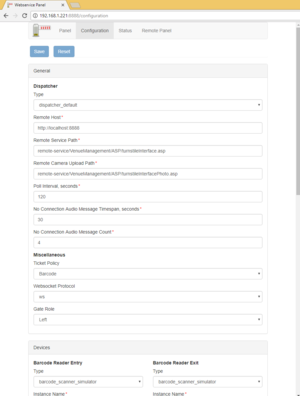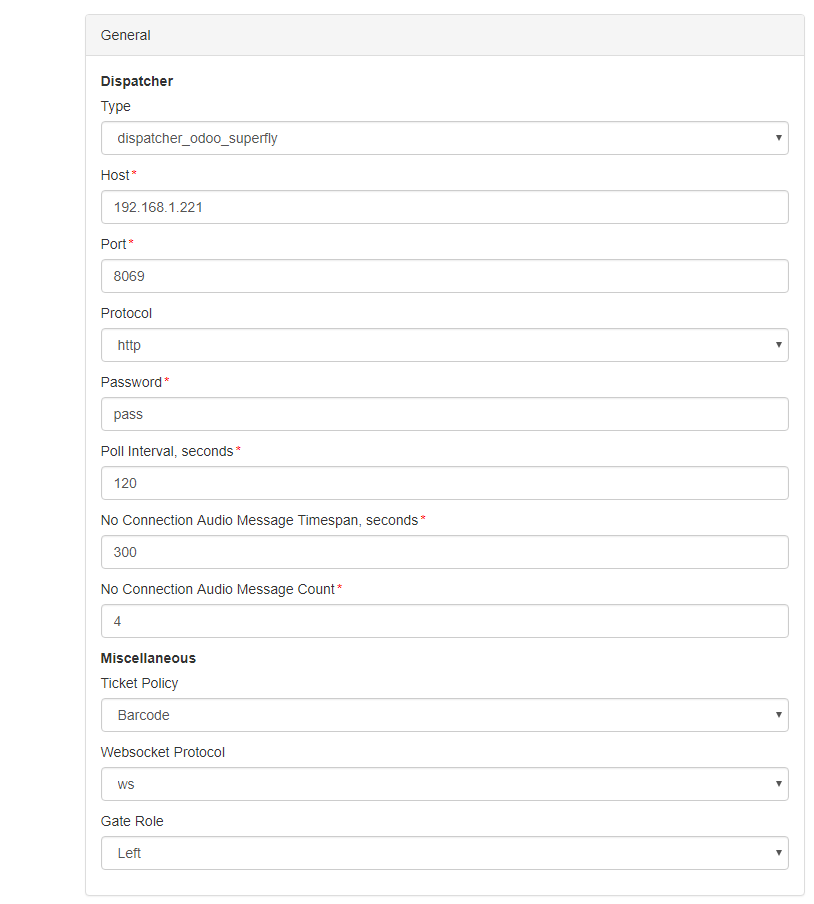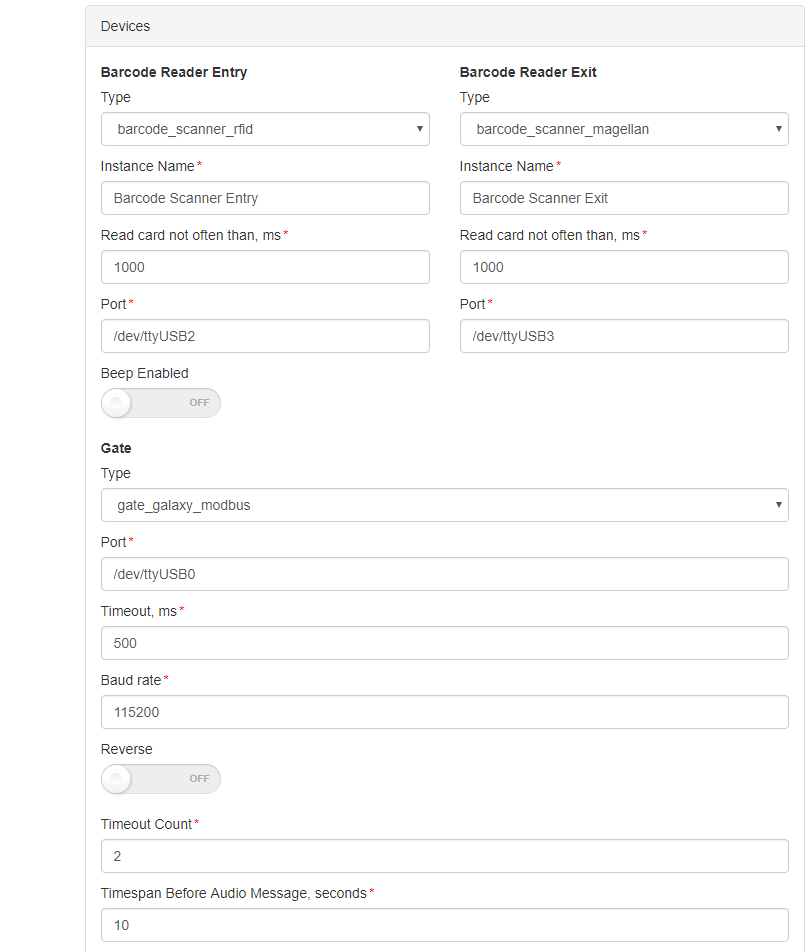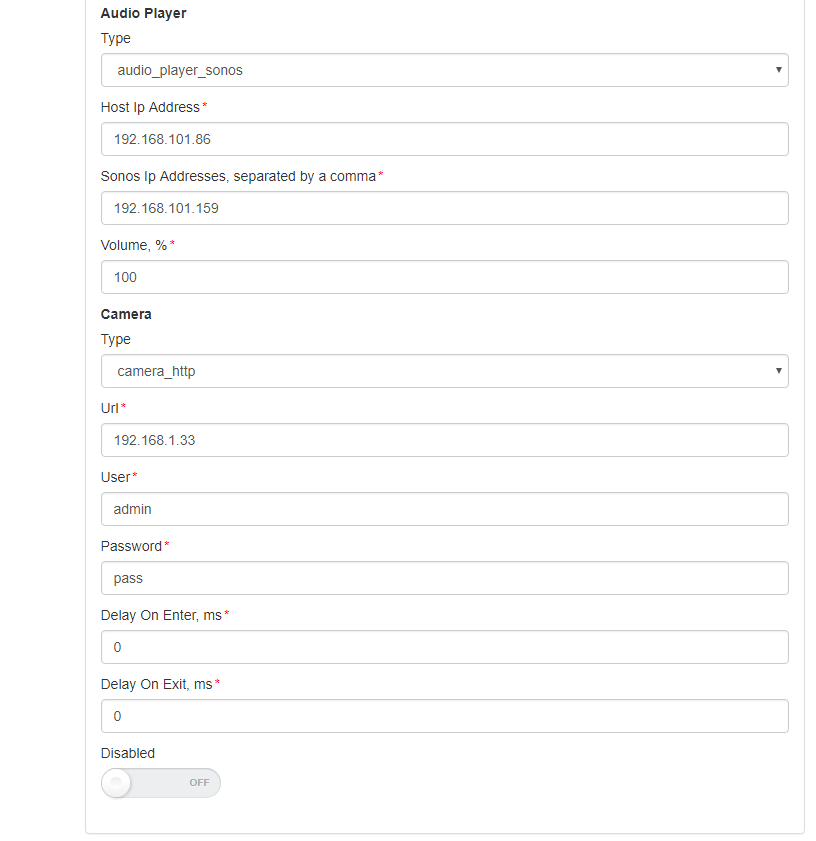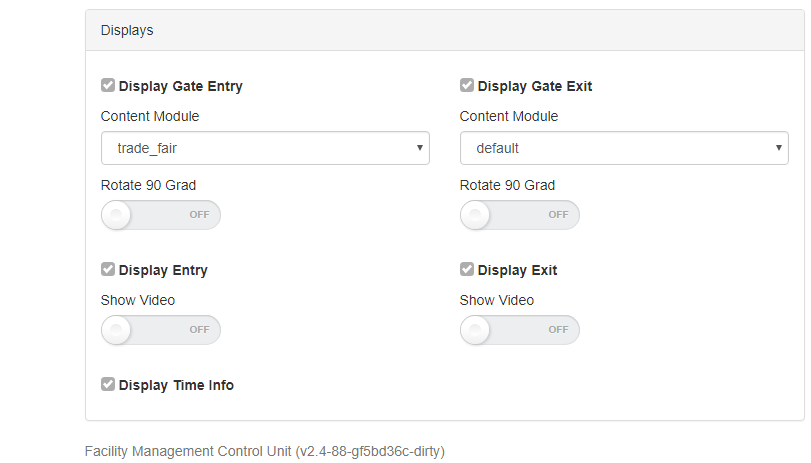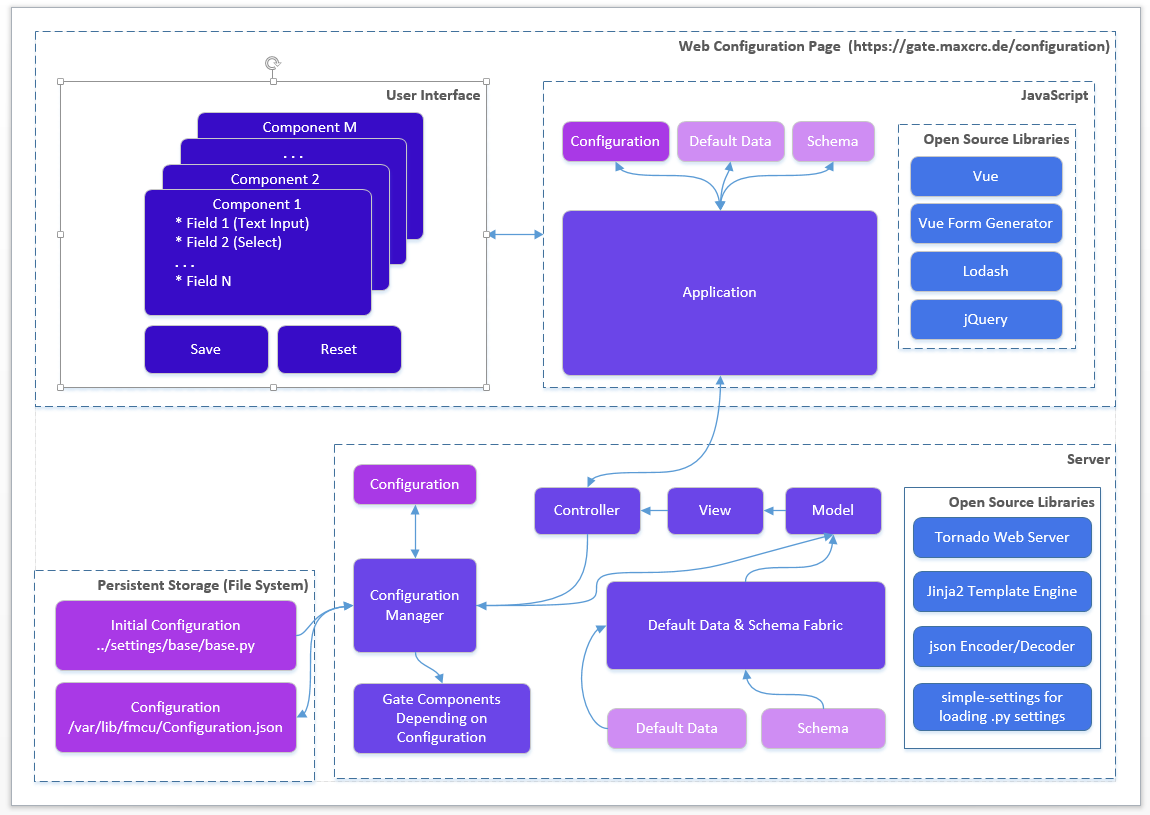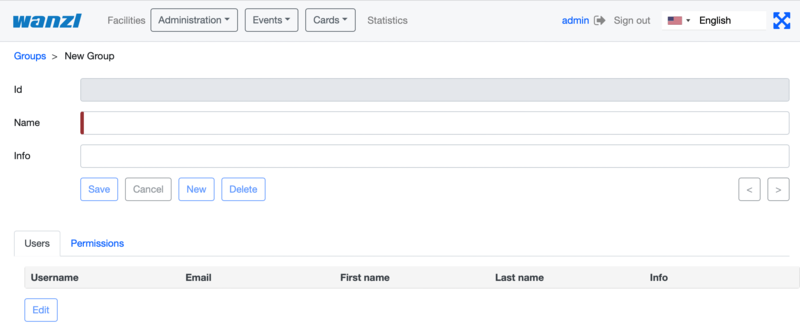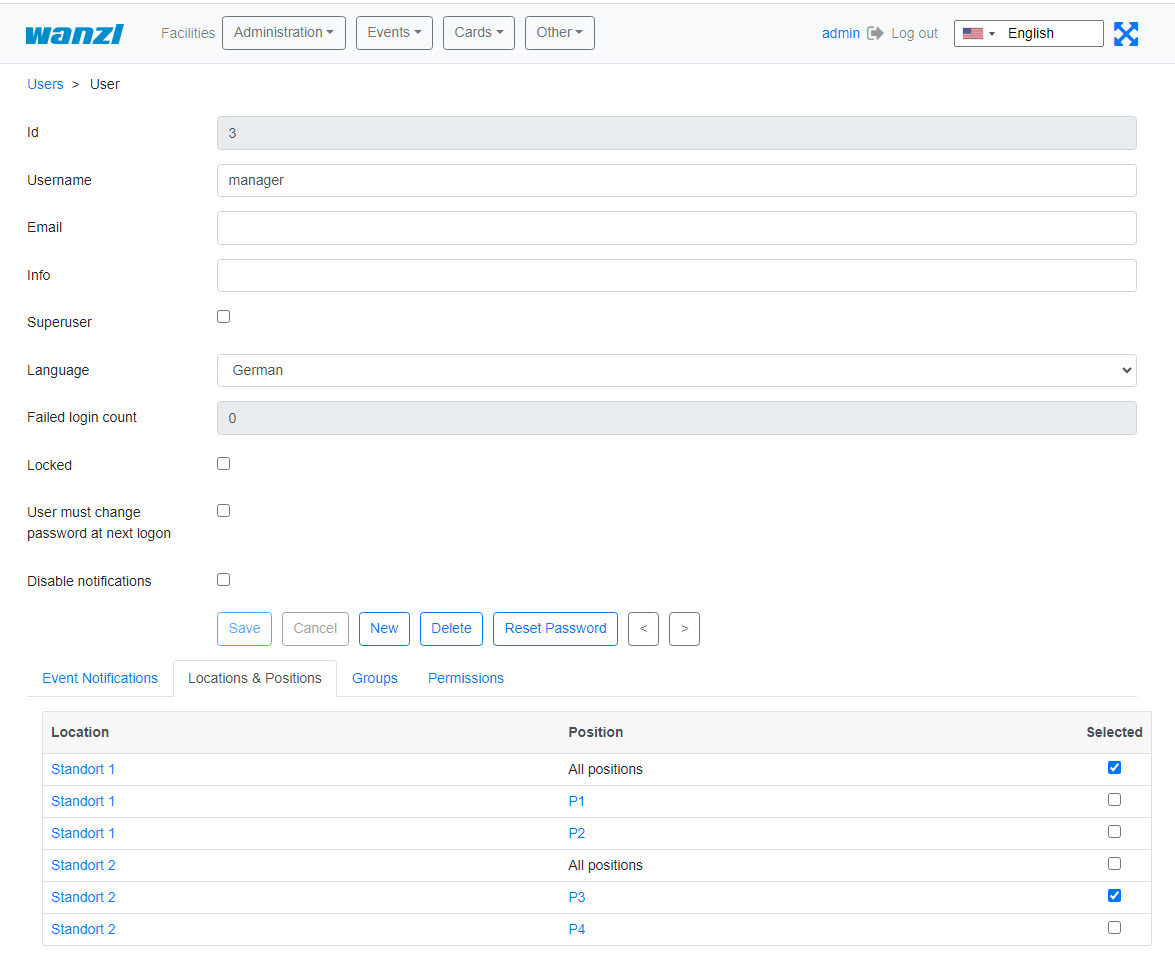Gate ~ FMCU ~ management dashboard/en: Unterschied zwischen den Versionen
← Gate ~ FMCU ~ management dashboard/en
(→Gates) (Markierung: 2017-Quelltext-Bearbeitung) |
(→Authorization) (Markierung: 2017-Quelltext-Bearbeitung) |
Inhaltsverzeichnis
- 1 General
- 2 Headline Sign Up
- 3 Gates3.1 Headline
- 4 Menu items .2
- 3
- 3
- 4 Connectivity Board
- 5 Configuration Management
- 6 Management of Events
- 7 Events
- 8 Event Definitions Page
- 9 Event Definition Groups
- 10 Event Subscriptions
- 11 Configuration
- 5 Administration
- 6 Events
- 7 Cards
- 8 Statistics
- 9 Additional Topics
General[Bearbeiten | Quelltext bearbeiten]
The Wanzl Access Manager offers a central dashbaord for access controls in a homogeneous interface, displays the corresponding states and supports the user in the administration of these components. The Wanzl Access Manager is a leading platform for monitoring and managing access controls of security areas.
Sign Up[Bearbeiten | Quelltext bearbeiten]
Please enter the login information provided by support here to log in to the central dashboard.
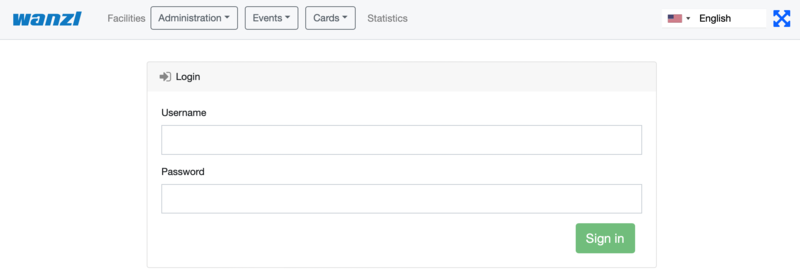
Headline[Bearbeiten | Quelltext bearbeiten]
| Nummer Number | Funktion Function |
|---|---|
| 1 | Button Management Dashboard |
| 2 | Administration |
| 3 | Events Button |
| 4 | Cards Button |
| 5 | Statistics Button |
| 6 | Logged in User |
| 7 | Log out Button |
| 8 | Languages menu |
| 9 | Adjust the display to entire width of the screen |
Menu items[Bearbeiten | Quelltext bearbeiten]
Facilities[Bearbeiten | Quelltext bearbeiten]
https://<dns-name or ip-address>/gates
In dieser Ansicht werden alle Zutrittskontrollen in einer intuitiven Oberfläche dargestellt. Es existieren Gruppierungsmöglichkeiten in zwei Kategorien. Zunächst kann man nach Standort gruppieren. Innerhalb des Standortes kann man dann verschiedene Lokationen zusammenfassen. Einzelne Gates können über den Menüpunkt "Neu" hinzugefügt werden.

this view, all access controls are displayed in an intuitive interface. There are grouping options in two categories. First, you can group by Location. Within the location you can then summarize different Locations.
Individual gates can be added via the menu item "New".
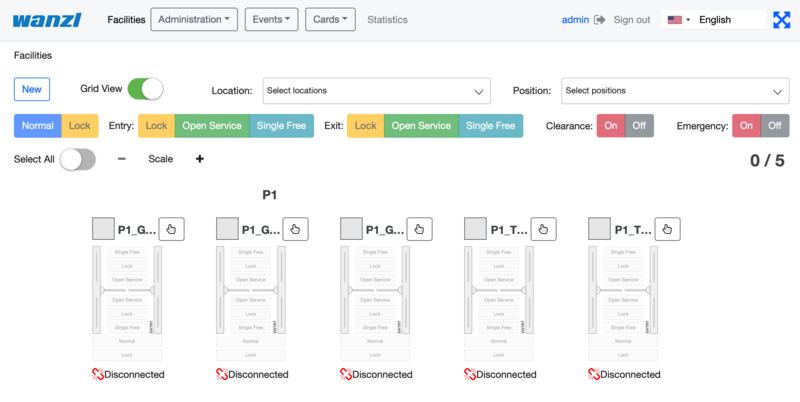
When the light view is off, the access controls are shown in the list.

When one or more facilities are selected with the control,
the facilities can be controlled with the following buttons:
The Gate display contains the following controls:
The symbols under the gate convey various information about it:
| Symbol | Description | Note |
|---|---|---|
| No connection to the gate | ||
| The gate is in the Normal state | ||
| The gate is in the Locked state | ||
| The gate is in the fire alarm state | ||
| The gate is in the emergency open state | ||
| The cleaning mode is active | ||
| Alarm is active at the gate | ||
| The gate is permanently open | ||
| One or more devices at the gate have failed | ||
| Current selected configuration of the gate | Only if there are two or more configurations at the gate |
Gate-View[Bearbeiten | Quelltext bearbeiten]
In this view, you can observe the state of each gate, control the gate, and apply the gate's configurations (if there are two or more).
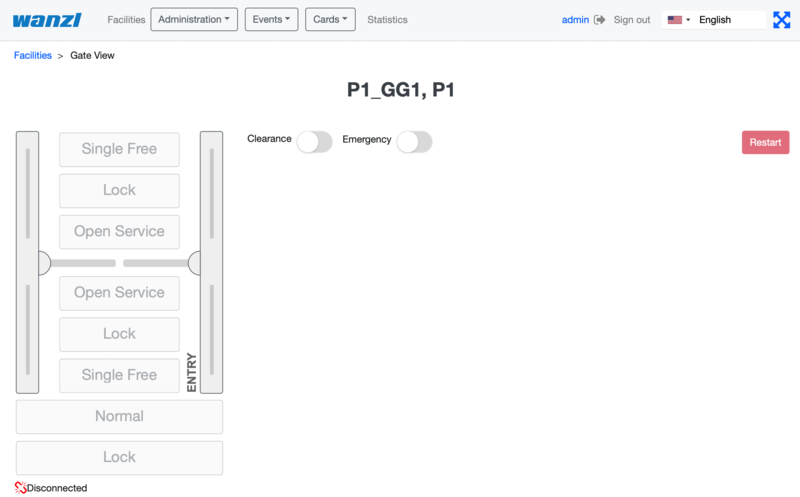
These buttons allow you to perform various actions:
Set up a new Gate[Bearbeiten | Quelltext bearbeiten]
In dieser Ansicht legen Sie ein neues Gate an. Die Felder Namen, Anzeigename und Position des Gates müssen mit Werten belegt werden. Danach auf Anlagen klicken.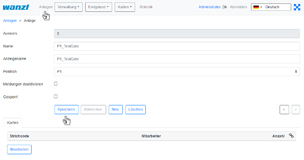
Sie sehen nun in der Ansicht das Sie ein NEUES Gate angelegt haben,
in diesem Fall das vierte Gate in dieser Ansicht.

Im nächsten Schritt verbinden Sie das Gate mit dem Server Please click the button New
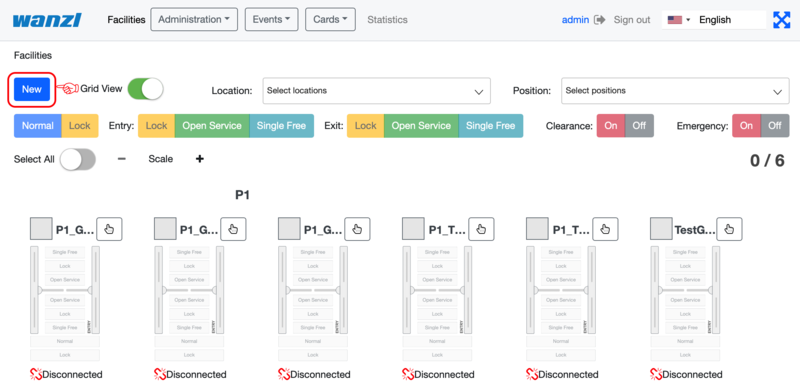
In this view you create a New gate. The fields Names, Displayed Name and Position of the Gate must be verified with values. Press Save then click on Facilities.
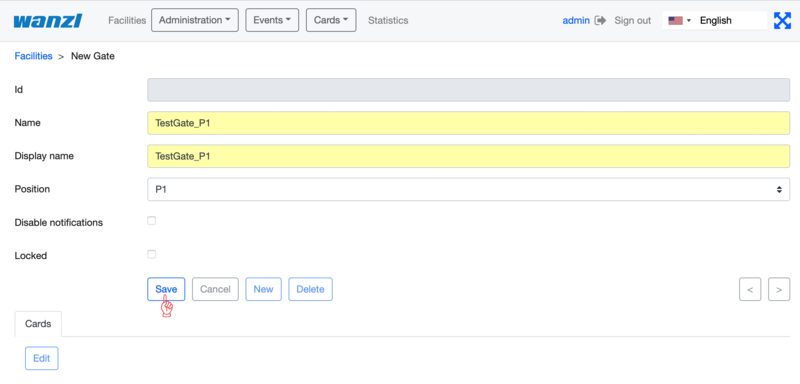
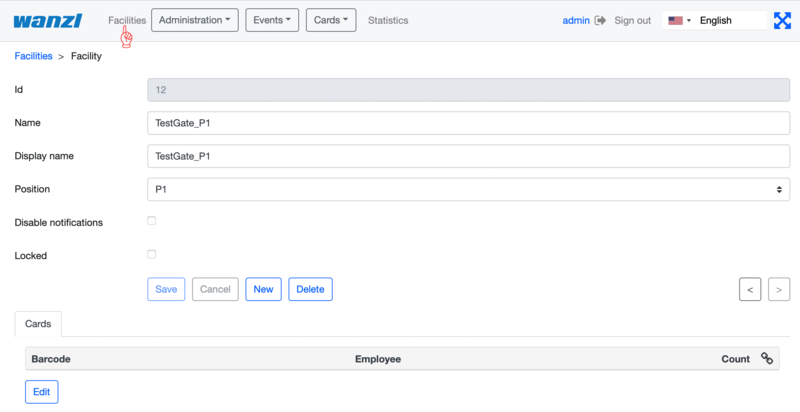
You can now see in the view that you have created a NEW gate,
in this case the sixth gate in this view.
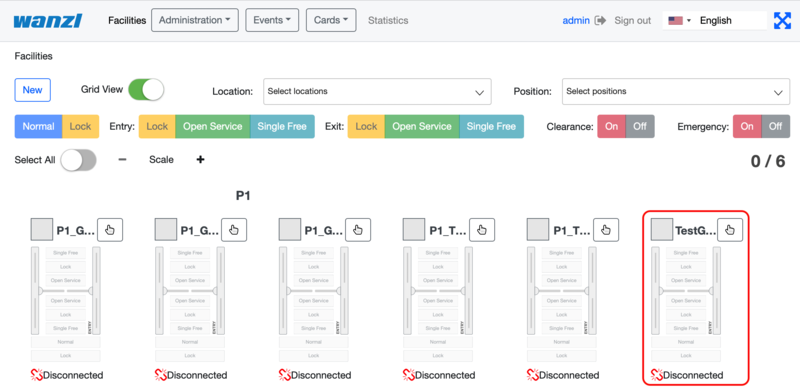
In the next step you connect the gate to the server.
https://<IP-Adresse des Dashboards>
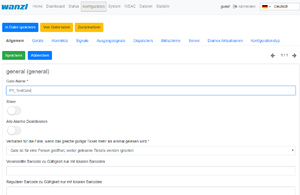
Prüfen Sie dann auf dem Reiter Server folgende Punkte.
To do this, check on the General tab that the correct gate name has been entered.

Then check the following points on the Server tab.
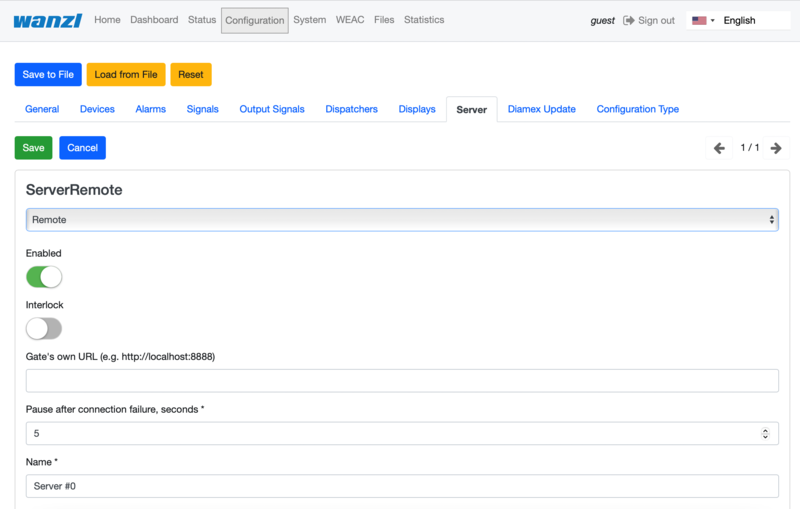
Server#0 (server)- muss auf Fern eingestellt sein.
Schiebeschalter Aktiviert ist aktiviert.
Unter Name* sollte ihr Server eingetragen sein.
Unter URL* sollte ihre URL eingetragen sein.
Unter Benutzername* sollte gate eingetragen sein.
Unter Passwort* sollte ihr Passwort eingetragen sein.
Am Ende Speichern.
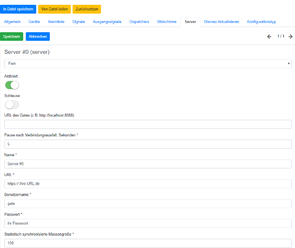 Im nächsten Schritt bitte in der oberen Leiste auf System klicken.
Im nächsten Schritt bitte in der oberen Leiste auf System klicken. 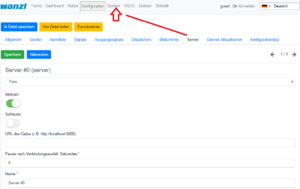 Sie bekommen jetzt folgende Darstellung, hier bitte einmal auf Neustart drücken. Jetzt sollte Ihr neues Gate verbunden sein.
Sie bekommen jetzt folgende Darstellung, hier bitte einmal auf Neustart drücken. Jetzt sollte Ihr neues Gate verbunden sein. 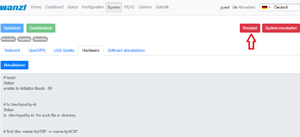 Sie können abschließend im Reiter Status noch die Verbindung prüfen. Unter Zustand muss jetzt VERBUNDEN erscheinen.
Sie können abschließend im Reiter Status noch die Verbindung prüfen. Unter Zustand muss jetzt VERBUNDEN erscheinen. 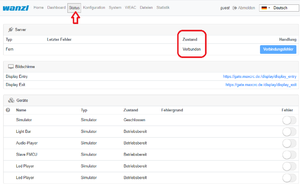
must be set to remote.
Activated slide-switch is activated.
Your server should be entered under Name*.
Your URL should be entered under URL*.
Gate should be entered under Username*.
Your password should be entered under Password*.
Save at the end.
In the next step, please click on System in the top bar.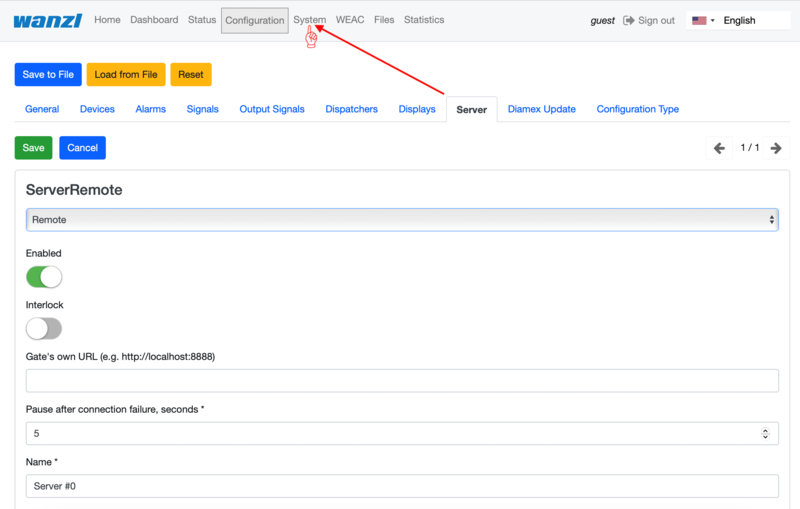
You will now see the following display, here please press restart once. Now your new gate should be connected.
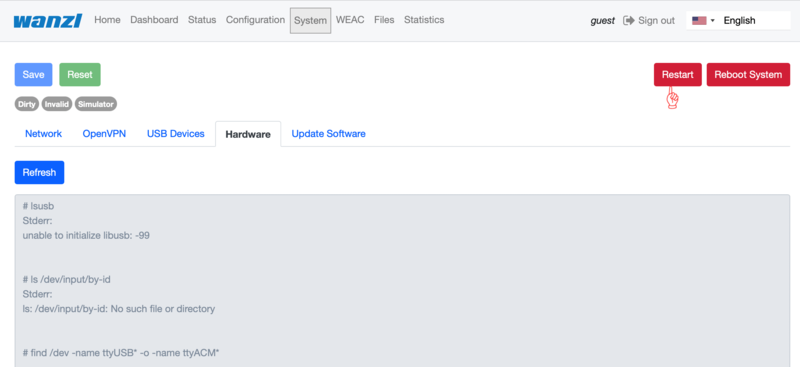
Finally, you can check the connection in the Status tab. CONNECTED must now appear under State.

Edit existing Gate[Bearbeiten | Quelltext bearbeiten]
https://<dns-name or ip-address>/gates
Verschieben Sie hier bitte den Schiebeschalter "Rasteransicht" nach links.
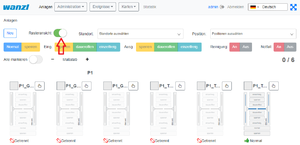 In der Ansicht klicken Sie auf den Namen des Gates welches Sie bearbeiten möchten (im Beispiel P1_TestGate2).
In der Ansicht klicken Sie auf den Namen des Gates welches Sie bearbeiten möchten (im Beispiel P1_TestGate2). 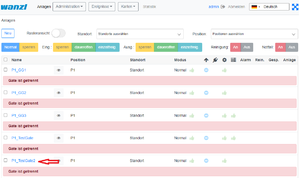
In dieser Ansicht bitte die Funktion "Bearbeiten" drücken.
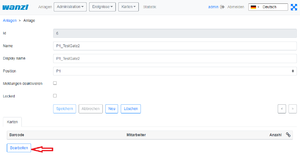
In dieser Ansicht können Sie nun das Gate bearbeiten.

You are in the same view as where you would create a new gate. Please move the slide switch "Grid view" to the left.
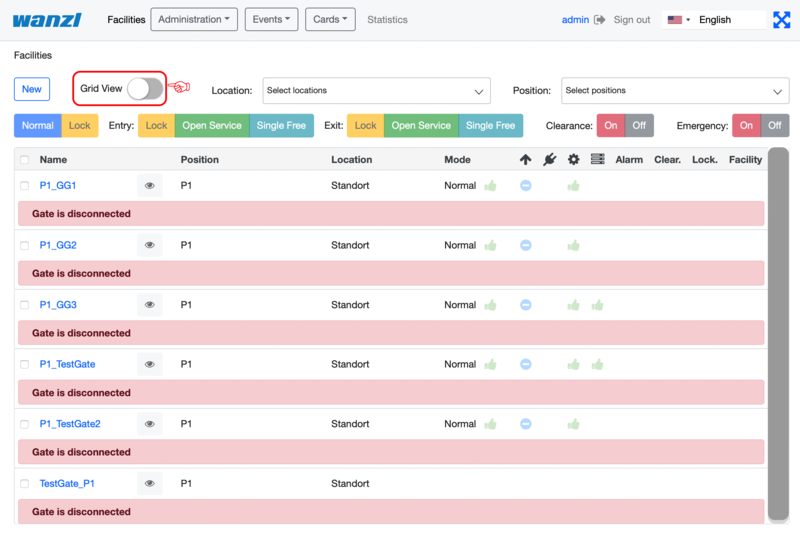
In the view click on the name of the gate which you want to edit (in the example TestGate_P1).

In this view, please press the "Edit" function.
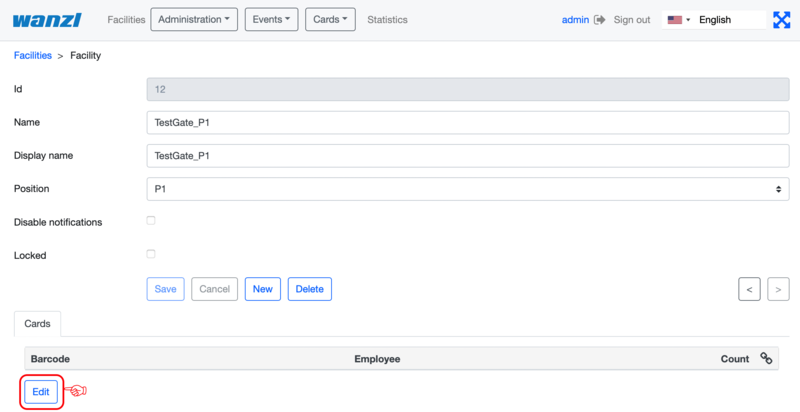
You can now edit the gate in this view.

Remove Gate[Bearbeiten | Quelltext bearbeiten]
https://<dns-name or ip-address>/gates
Verschieben Sie hier bitte den Schiebeschalter "Rasteransicht" nach links.

In der Ansicht klicken Sie auf den Namen des Gates welches Sie löschen möchten (im Beispiel P1_TestGate6).

In dieser Ansicht bitte die Funktion "Löschen" drücken.
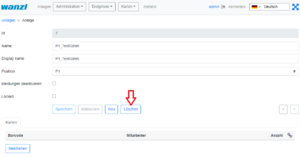
Es wird nun zur Sicherheit nochmal abgefragt ob Sie das Element wirklich löschen möchten? Bestätigen Sie dies bitte.

Sie bekommen nach dem Löschen schon automatisch das nächste Gate angezeigt (hier im Beispiel P1_TestGate2). Hier bitte auf Anlagen drücken.

Sie sehen dann in der Rasteransicht das, das Gate P1_TestGate6 fehlt und erfolgreich gelöscht wurde.
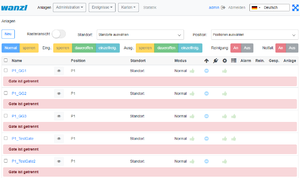 Connectivity Board
Connectivity Board
You are in the same view as where you would create a new gate.
Please move the slide switch "Grid view" to the left.

In the view click on the name of the gate which you want to delete (in the example TestGate_P1).

In this view, please press the "Delete" function.
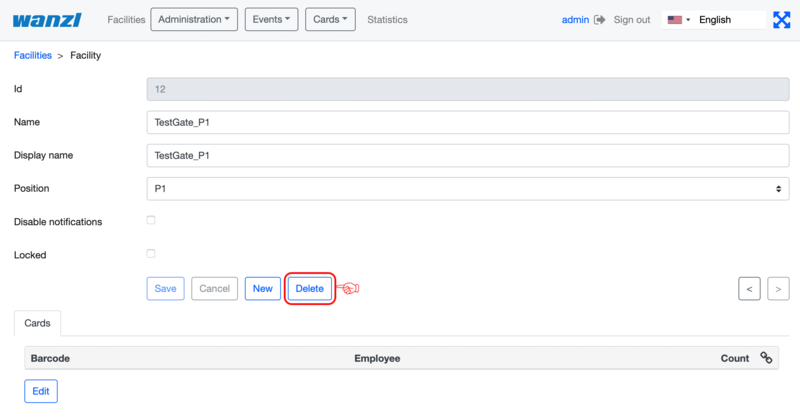
To be on the safe side, you will now be asked again whether you really want to delete the element? Please confirm this.

After deleting, you will automatically be shown the next gate (in the example P1_TestGate2). Please click on Facilities here.
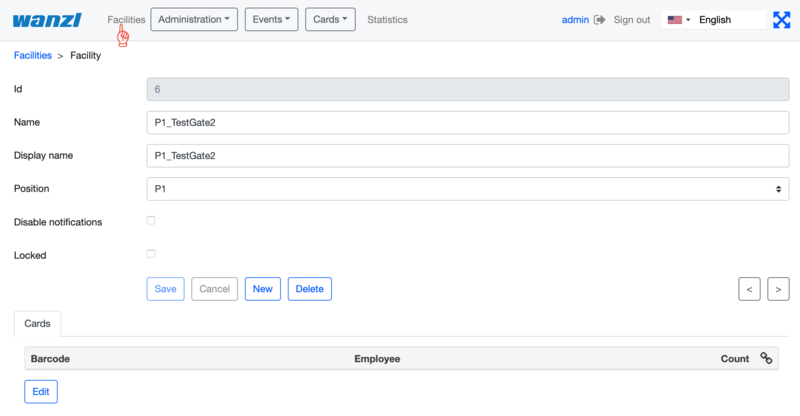
You will then see in the Grid View that Gate TestGate_P1 is missing and has been successfully deleted.

Administration[Bearbeiten | Quelltext bearbeiten]
| Contact | Type | Impulse | Description |
|---|---|---|---|
| A8 | Output | Yes (500 ms) | Person has entered |
| A9 | Output | Yes (500 ms) | Alarms* |
| E3 | Input | Yes (500 ms) | Open Entry |
| E4 | Input | Yes (500 ms) | Open Exit |
| E6 | Input | Yes (200ms) | Card is valid, open the gate |
| E7 | Input | Yes (200ms) | Card is invalid, do not open the gate |
| E8 | Input | No | Emergency State button** |
| E9 | Input | Yes (500 ms) | Open Entry 70% |
| E10 | Input | No | Fire Alarm |
*A9 Alarms:
- Gate is out of order, when a mandatory device is broken or a connection to the server is broken (if the server is used in the solution).
- Tailgating or other unwanted actions.
- Entry barcode scanner is broken or it is a stub.
- Gate in in the Fire Alarm or Emergency state. The alarm is produces as a repetitive pulse signal (700ms).
- Gate is open only for exit.
After the Emergency State button pressed, the gate switches to the Emergency State. Then only exit from this state is to restart the gate.
The signal can be set/received to/from a contact from any of the halves of the gate.
Configuration Management[Bearbeiten | Quelltext bearbeiten]
User InterfaceThe Galaxy Gate is configured through the /configuration page. If the server is running at 192.168.1.221 and port is 8888, the url is:
http://192.168.1.221/configuration
There are two buttons on the page:
| Name | Description | Action |
|---|---|---|
| Save | Saves the modified configuration to the server | Post |
| Reset | Discards any changes by reloading the configuration from the server | Get |
The configuration is split into sections and subsections:
-
General
- Dispatcher
- Miscellaneous
-
Devices
- Barcode Reader Entry
- Barcode Reader Exit
- Gate
- Tracking Camera
- Audio Player
- Camera
-
Displays
- Display Gate Entry
- Display Gate Exit
- Display Entry
- Display Exit
- Display TimeInfo
Here are some screenshots:
A subsection is often has a structure with a combo box named Type at the top and some fields that follow. This structure is used for configuring an entity that can have several implementations. What is important is that the implementation can differ in type and number of controls. For example, a simulator of the gate has only two properties:
Architecture[Bearbeiten | Quelltext bearbeiten]
The picture below gives a bird's eye view of the configuration management.
When the gate starts and the Configuration.json is present it is created from the Initial Configuration (base.py or other .py configuration file). The Schema contains a set of data for describing controls in form components:
- Which controls should contain a component
- Validations rules if any
E.g. a form component can contain a text box and an input for integers. The data range for integer should 1-100.
The Default Data contains the initial data for controls in form components.
Edit this sectionRoadmap[Bearbeiten | Quelltext bearbeiten]
The features are planned for the upcoming release:
-
Configurations page allows you to see the list of available configurations. You can:
- Clone an existing configuration to a new one
- Delete a configuration
- Make a configuration active. Only one configuration can be used by the server and it is called active.
- Apply button. This should apply changes on-the-fly.
- Restart button. This should restart the docker container and apply settings, which cannot be applied on-the-fly.
-
Extend the vue form generator library:
- Make the switch control consistent with the switch controls on other pages
- Add a control which allows you to manage an array of items (e.g. the list of connected gates). E.g. https://codepen.io/safx/pen/AhCtk
- Import/Export of a Configuration.json.
- Reset any configuration to the default one (by removing the json file
Management of Events[Bearbeiten | Quelltext bearbeiten]
The following sections contains the term Path, which means the path is part of the URL. E.g., path /events for the FMCU Server running under https://server.maxcrc.de/ means
https://server.maxcrc.de/events
Events[Bearbeiten | Quelltext bearbeiten]
Web path:
/events
The page shows a filterable and sortable list of events:
| Name | Description |
|---|---|
| Date | Date and time when the event occurred |
| Name | Translated name of the event |
| Gate | Gate if appropriate where the event occurred |
| State | The state of the event if supported |
| Category | Category to which the event belongs to |
| Info | Additional info about the event |
Edit this section
Event Definitions Page[Bearbeiten | Quelltext bearbeiten]
Path:
/event-definitions
The page shows a list of definitions of events:
| Name | Description |
|---|---|
| Name | Name |
| Event Definition Groups | Groups to which the event belongs to if any |
| Supported States | Can be empty (for impulse events) or On, Off (for the events with states) |
| Category | Category to which the event belongs to |
Edit this section
Event Definition Groups[Bearbeiten | Quelltext bearbeiten]
Path:
/event-definition-groups
The page shows a list of event groups:
| Name | Description |
|---|---|
| Name | Name |
| Events | Event definitions assigned to the group |
| Delete | Delete button |
An event definition group allows you to group one or more events so that it can be bound to a user group. See Event Subscriptions below
Edit this section
Event Subscriptions[Bearbeiten | Quelltext bearbeiten]
Web path:
/event-subscriptions
The page shows a list of event definition groups bound to a user groups.
| Name | Description |
|---|---|
| Group | User group |
| Event definition group | Event definition group |
| Locked | When locked, events are not sent to the users of the group |
| Info | Any informative text |
| Delete | Delete button |
When a event definition group is bound to a user group and not locked, new events from the event definition group are sent to the users from the user group. The user must have a valid email address.
Example. A user group Alarm events with two members user1 and user2 is bound to an event definition group Alarm events with two events GateTailgating and GateStateFireAlarm. When either or both of these events occur, both users user1 and user2 receive an email notification about that.
Edit this section
Configuration[Bearbeiten | Quelltext bearbeiten]
Path:
/configuration
In order the emails with events can be sent out, the Email section with the information like the hostname, port etc. of the outgoing server and credentials should be properly configured.
User[Bearbeiten | Quelltext bearbeiten]
https://<dns-name or ip-address>/users
On this page you can see an overview of all users

| Number | Function |
|---|---|
| 1 | Create new user |
| 2 | Filter users by location |
| 3 | Filter users by position |
Set up new User[Bearbeiten | Quelltext bearbeiten]
Press under User on the button New
https://<dns-name or ip-address>/new-user
| Field Name | Description |
|---|---|
| Id | Automatically generated unique number of the user |
| Username* | Username of the user to login |
| Password* | User's password for login |
| Email address of the user for sending log messages | |
| First name | User's first name |
| Last name | Last name of the user |
| Info | Description of the user |
| Superuser | The highest rights are assigned to the user |
| Locked | The user's login is blocked |
| Disable notifications | The user does not receive any notifications in the FMCU Management Dashboard |
* Strictly required fields Through the button Save the new user is created.
Edit existing User[Bearbeiten | Quelltext bearbeiten]
Press under User a user to edit

Event Notifications[Bearbeiten | Quelltext bearbeiten]
Under this tab, the notifications can be selected which the user should receive.
Note: If the checkbox Disable notifications is set, no notifications are displayed regardless of these settings.

Locations & Positions Tab[Bearbeiten | Quelltext bearbeiten]
You can set different locations in countries and cities. Separate access rights can be defined for each location via the authorization model.

Groups Tab[Bearbeiten | Quelltext bearbeiten]
This tab allows you to customize the user's group memberships.
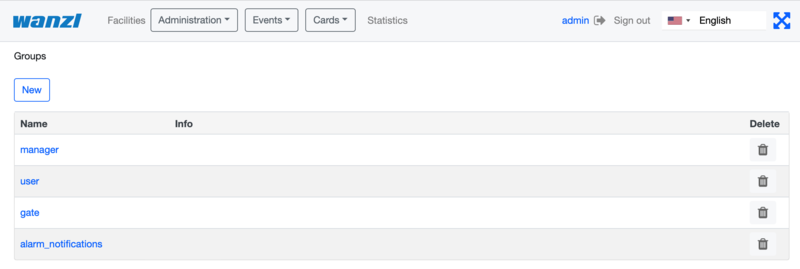
Permissions Tab[Bearbeiten | Quelltext bearbeiten]
The user's permissions are displayed under this tab

All changes are applied by clicking the Save button.
Groups[Bearbeiten | Quelltext bearbeiten]
https://<dns-name or ip-address>/groups
On this page you can see an overview of all groups
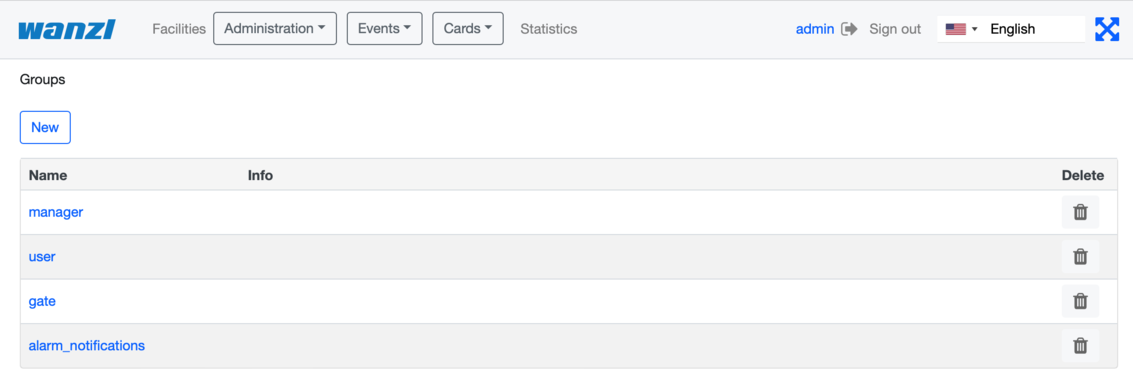
Set up new Group[Bearbeiten | Quelltext bearbeiten]
https://<dns-name or ip-address>/new-group
Click under Gruppen the button New

please enter a group name, optional you can write a description to the group
| Field Name | Description |
|---|---|
| Id | Automatically generated unique number of the group |
| Name | Name of the Group |
| Info | Description of the Group |
* Strictly required fields
The new group is created by clicking the Save button.
Edit existing Group[Bearbeiten | Quelltext bearbeiten]
Click under Gruppen the Group you want edit

Users Tab[Bearbeiten | Quelltext bearbeiten]
This tab allows you to customize the members of the group.
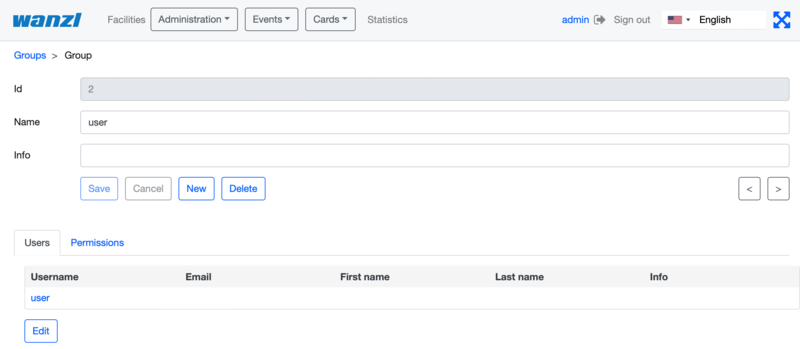
Permissions Tab[Bearbeiten | Quelltext bearbeiten]
The permissions that are inherited by the members of the group are displayed under this tab.
All changes are applied by clicking the Save button.

Positions[Bearbeiten | Quelltext bearbeiten]
https://<dns-name or ip-address>/cities
On this page you can see an overview of all positions

Set up new Position[Bearbeiten | Quelltext bearbeiten]
https://<dns-name or ip-address>/new-city
Under Positions click on the button New
Enter the name of the position and assign the position to a location using the dropdown field.

Click on the Save button to create the position
Edit existing Position[Bearbeiten | Quelltext bearbeiten]
Under Positions click to edit the position

Here you can edit the position name and location

Locations[Bearbeiten | Quelltext bearbeiten]
https://<dns-name or ip-address>/countries
On this page you can see an overview of all locations

Set up new Location[Bearbeiten | Quelltext bearbeiten]
https://<dns-name or ip-address>/new-country
Press under Locations the button New


| Field Name | Description |
|---|---|
| Id | Automatically generated unique number of the location |
| Name* | Location name |
| Info | Description of the location |
* Strictly required fields
Click on the Save button to create the position
Edit existing Location[Bearbeiten | Quelltext bearbeiten]
Under Location , click the location you want to edit

Here you can edit the name, code and info of the location

Locations & Positions[Bearbeiten | Quelltext bearbeiten]
https://<dns-name or ip-address>/locations
Here you can see an overview of all positions and their assigned locations

Configuration[Bearbeiten | Quelltext bearbeiten]
https://<dns-name or ip-address>/configurations
Events[Bearbeiten | Quelltext bearbeiten]
Events[Bearbeiten | Quelltext bearbeiten]
https://<dns-name or ip-address>/events
In this view, the events of all access controls are shown in an intuitive list view. There are filtering options and a name search for the events.

The following filters can be set:
- Location
- Position
- Facility
- Search by Event name
- Time Period
Event Definitions[Bearbeiten | Quelltext bearbeiten]
https://<dns-name or ip-address>/event-definitions
In this view, all events that the FMCU contains are listed and their event definition groups, supported states and categories are assigned.

Event definition Groups[Bearbeiten | Quelltext bearbeiten]
https://<dns-name or ip-address>/event-definition-groups
All event definition groups are listed under this tab.

Create a new Event definition Group[Bearbeiten | Quelltext bearbeiten]
Click Event defenition groups on the Button New
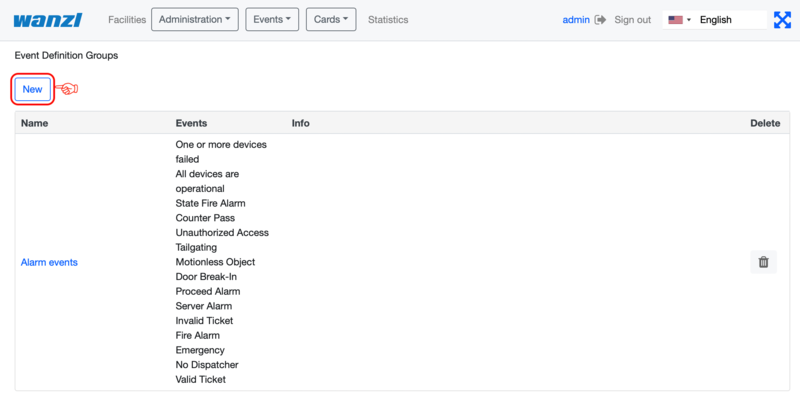

| Fieldname | Description |
|---|---|
| ID | Automatically generated unique group number |
| Name | Name of the group |
| Info | Group description |
* Absolutely required fields
Under the Event defenition tab select the event definitions that are to be assigned to the group.
Event Subscriptions[Bearbeiten | Quelltext bearbeiten]
https://<dns-name or ip-address>/event-subscriptions
There is the possibility to link groups of alarm messages with groups of users. As a result, only group members are notified of alarm messages that are also grouped,

| Fieldname | Description |
|---|---|
| ID | internal value |
| Group | Summary of users |
| Ereignisdefinitionsgruppe | Event definition group |
| Locked | Notifications deactivated/activated |
| Info | Description field |
Notifications[Bearbeiten | Quelltext bearbeiten]
https://<dns-name or ip-address>/notifications
Sent notifications are displayed in this overview. You can adjust the view accordingly using a date filter.

Cards[Bearbeiten | Quelltext bearbeiten]
Cards[Bearbeiten | Quelltext bearbeiten]
https://<dns-name or ip-address>/cards
This view shows an overview of the RFID cards in the system with the gates enabled for access.

Edit Cards[Bearbeiten | Quelltext bearbeiten]
https://<dns-name or ip-address>/cards-edit
In this view, cards can be added / removed and authorizations for individual gates can be defined.

After you push the Add Button you will be shown the following window

| Field | Description |
|---|---|
| Barcode | Card content that is captured by the reader |
| Employee | Description field |
| Employee ID | Description field |
| Quantity | Number of accesses for this card |
Statistics[Bearbeiten | Quelltext bearbeiten]
In this view, all activities for the assigned access controls are shown. You can adjust the view with date filters. It is possible to group the screen output, e.g. only to evaluate the number per day or month. Finally, the data can be exported in Excel format or CSV-format.
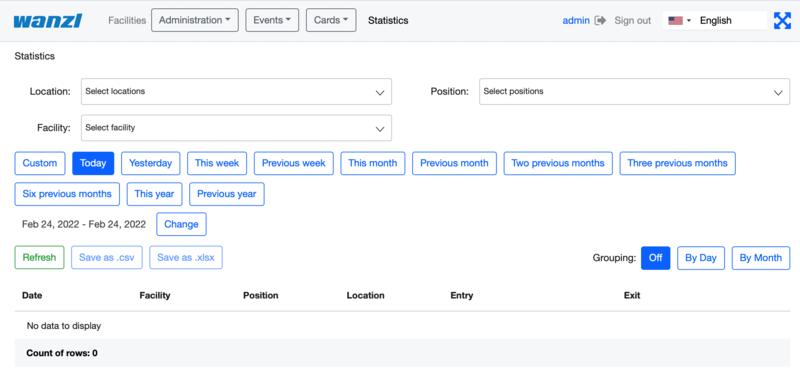
Additional Topics[Bearbeiten | Quelltext bearbeiten]
Authorization[Bearbeiten | Quelltext bearbeiten]
Access to certain resources provided by the application, e.g. facilities, actions, user interface elements, can be limited or unlimited. Access is unlimited if the user is a superuser. Any superuser can set or remove the Superuser property for any other user. Access for non-superuser users can be restricted by their groups (group-level permissions) and/or locations (location-level permissions).
Group-Level Authorization[Bearbeiten | Quelltext bearbeiten]
Group-level authorization is implemented through group permissions, which are a set of boolean values (true/false) that allow/deny group users access to various resources. The permissions are divided into categories and subcategories for easier navigation.
The image shows the permissions for the Manager group. If a checkbox is set, the resource is allowed for the users, otherwise it is denied.
Here are some examples of permissions:
- Actions / Facility / Mode / ServiceEntry. If the action ServiceEntry is set, the users of this group can open the gate in the entry direction, otherwise they cannot.
- Tables / audit / Read. The Administration | Audit page displays data from the audit database table. By default, access to the audit table is denied to all groups. This means that the data on the Administration | Audit page is only displayed to superusers.
- Views | Menu | Administration | Groups. If the Groups checkbox is set, the menu item is shown to the users, otherwise it is hidden.
The permissions are divided into the following top categories:
| Category | Description | Example |
|---|---|---|
| Actions | Actions, the user can execute from the dashboard | ServiceEntry, allow/deny users to permanently open facilities in entry direction |
| Tables | Create, read, update and delete records in database tables | Allow/deny users to access the audit table |
| Views | Show/hide user interface elements | Show/hide the Administration / Groups menu |
Location-Level Authorization[Bearbeiten | Quelltext bearbeiten]
Location-level authorization means that some location-aware resources, such as facilities, groups, and users, can be assigned to one or more locations and/or positions, so that the user can access only those resources that have the same locations.
For example, there are two locations: Standort1 with positions P1 and P2 and Standort2 with positions P3 and P4:
In the above picture, All positions means P1 and P2 for Standort1 and P3 and P4 for Standort2.
If we take the user manager and select locations and positions like in the picture below
then the user manager will have access to other location-aware resources (users, groups and facilities) as follows:
| Position | Access allowed |
|---|---|
| P1 | Yes |
| P2 | Yes |
| P3 | Yes |
| P4 | No |
{{translate|Gate ~ FMCU Galaxy Gate ~ management dashboard}}
==General==
Wanzl Access Manager ~ Management Dashboard}}
{{DISPLAYTITLE:Wanzl Access Manager ~ Management Dashboard}}
__TOC__
<br />
<br />
<br />
<br />
=General=
<br />
The Wanzl Access Manager offers a central dashbaord for access controls in a homogeneous interface, displays the corresponding states and supports the user in the administration of these components. The Wanzl Access Manager is a leading platform for monitoring and managing access controls of security areas.
<br />
==Headline==
[[Datei:Gate ~ FMCU ~ management dashboard <br />
=Sign Up=
<br />
Please enter the login information provided by support here to log in to the central dashboard.
<br />
[[Datei:Signupfmcu.png|800x800px]]
<br />
=Headline=
<br />
[[Datei:FMCU_Headline.png|links|rahmenlos|1000x1000px]]
<br />
{| class="wikitable"
!Nummer
!FunktionNumber
!Function
|-
|1
|Button Management Dashboard
|-
|2
|Administration
|-
|3
|Events Button
|-
|4
|Cards Button
|-
|5
|Statistics Button
|-
|6
|Logged in User
|-
|7
|Log out Button
|-
|8
|Languages menu
|-
|9
|Adjust the display to entire width of the screen
|}
==Gates==
<br />
=Menu items=
<br />
==Facilities==
<br />
<syntaxhighlight>
https://<dns-name or ip-address>/gates
</syntaxhighlight>
In dieser Ansicht werden alle Zutrittskontrollen in einer intuitiven Oberfläche dargestellt. Es existieren Gruppierungsmöglichkeiten in zwei Kategorien. Zunächst kann man nach '''Standort''' gruppieren. Innerhalb des Standortes kann man dann verschiedene '''Lokationen''' zusammenfassen.
Einzelne Gates können über den Menüpunkt "'''Neu'''" hinzugefügt werden.
[[Datei:FMCU1.png|ohne|mini]]
===Set up a new Gate===
In dieser Ansicht legen Sie ein '''neues''' Gate an. Die Felder '''Namen''', '''Anzeigename''' und '''Position''' des Gates müssen mit Werten belegt werden. Danach auf Anlagen klicken.[[Datei:FMCU3.png|ohne|mini|304x304px]]
Sie sehen nun in der Ansicht das Sie ein '''NEUES''' Gate angelegt haben,
in diesem Fall das vierte Gate in dieser Ansicht.
[[Datei:FMCU4.png|ohne|mini|299x299px]]
Im nächsten Schritt verbinden Sie das Gate mit dem Server.
<syntaxhighlight>
https://<IP-Adresse des Dashboards>
</syntaxhighlight>Prüfen Sie hierzu auf dem Reiter '''Allgemein''' das der korrekte Gate-Name eingetragen ist.
[[Datei:FMCU5.png|ohne|mini]]
Prüfen Sie dann auf dem Reiter '''Server''' folgende Punkte.
Server#0 (server)- muss auf Fern eingestellt sein.
Schiebeschalter Aktiviert ist aktiviert.
Unter Name* sollte ihr Server eingetragen sein.
Unter URL* sollte ihre URL eingetragen sein.
Unter Benutzername* sollte gate eingetragen sein.
Unter Passwort* sollte ihr Passwort eingetragen sein.
Am Ende '''Speichern.'''
[[Datei:FMCU7.png|ohne|mini|295x295px]]
Im nächsten Schritt bitte in der oberen Leiste auf System klicken.
[[Datei:FMCU9.png|ohne|mini]]
Sie bekommen jetzt folgende Darstellung, hier bitte einmal auf Neustart drücken.
Jetzt sollte Ihr neues Gate verbunden sein.
[[Datei:FMCU10.png|ohne|mini]]
Sie können abschließend im Reiter '''Status''' noch die Verbindung prüfen. Unter Zustand muss jetzt '''VERBUNDEN''' erscheinen.
[[Datei:FMCU11.png|ohne|mini]]<br />
=== Edit existing Gate ===
this view, all access controls are displayed in an intuitive interface. There are grouping options in two categories. First, you can group by '''Location'''. Within the location you can then summarize different '''Locations'''.
<br />
Individual gates can be added via the menu item "'''New'''".
<br />
[[Datei:FMCU_Facilities.png|800x800px]]
<br />
When the light view is off, the access controls are shown in the list.
<br />
[[Datei:FMCU_GridView.png|800x800px]]
<br />
When one or more facilities are selected with the control,
<br />
[[Datei:FMCU-Server-Check-Select.png|ohne|link=]]
<br />
the facilities can be controlled with the following buttons:
<br />
{| class="wikitable"
|+
!'''Symbol'''
!'''Description'''
!'''Note'''
|-
|[[Datei:FMCU_Normal_Lock_Button.png|rahmenlos|160x160px]]
|change to normal state, lock the doors in both directions
|
|-
|[[Datei:FMCU Lock OpenService Single.png|rahmenlos]]
|open the door permanently or open it for a single person
|towards the entrance
|-
|[[Datei:FMCU Lock OpenService Single.png|rahmenlos]]
|open the door permanently or open it for a single person
|toward the exit
|-
|[[Datei:FMCU_On_Off_Button.png|rahmenlos|98x98px]]
|Turn the '''Cleaning''' mode on and off
|cleaning
|-
|[[Datei:FMCU_On_Off_Button.png|rahmenlos|98x98px]]
|Toggle '''Emergency Open''' mode on and off
|Emergency
|}
<br />
<br />
The Gate display contains the following controls:
{| class="wikitable"
|+
!'''Symbol'''
!'''Description'''
!'''Note'''
|-
|[[Datei:FMCU-Server-Check-Select.png|ohne|link=]]
|choose the gate
|to activate the buttons above ('''Normal''', '''Lock Out''', etc.)
|-
|[[Datei:FMCU-Server-Link-Gate.png|ohne|link=]]
|Navigate to the '''Facilities''' page
|
|-
|[[Datei:FMCU-Server-Button-Gate-View.png|ohne|link=]]
|Navigate to the page'''Gate-View'''
|
|-
|[[Datei:FMCU Normal Button.png|rahmenlos|212x212px]]
|change to Normal state
|
|-
|[[Datei:FMCU Lock Button.png|rahmenlos|210x210px]]
|lock the doors in both directions
|
|-
|[[Datei:FMCU Single Free Button.png|rahmenlos|126x126px]]
|open the door in the direction of entrance/exit for a single person
|
|-
|[[Datei:FMCU Single Free Button.png|rahmenlos|126x126px]]
|lock the door in the direction of entrance/exit
|
|-
|[[Datei:FMCU Open Service Button.png|rahmenlos|125x125px]]
|permanently open the door in the direction of entrance/exit
|
|}
<br />
The symbols under the gate convey various information about it:
{| class="wikitable"
|+
!'''Symbol'''
!'''Description'''
!'''Note'''
|-
|[[Datei:FMCU-Server-Disconnected.png|ohne|link=]]
|No connection to the gate
|
|-
|[[Datei:FMCU-Server-Icon-Normal.png|ohne|link=]]
|The gate is in the Normal state
|
|-
|[[Datei:FMCU-Server-Icon-Locked.png|ohne|link=]]
|The gate is in the Locked state
|
|-
|[[Datei:FMCU-Server-Icon-Firealarm.png|ohne|link=]]
|The gate is in the fire alarm state
|
|-
|[[Datei:FMCU-Server-Icon-Emergency.png|ohne|link=]]
|The gate is in the emergency open state
|
|-
|[[Datei:FMCU-Server-Icon-Clearance.png|ohne|link=]]
|The cleaning mode is active
|
|-
|[[Datei:FMCU-Server-Icon-Alarm.png|ohne|link=]]
|Alarm is active at the gate
|
|-
|[[Datei:FMCU-Server-Icon-Service.png|ohne|link=]]
|The gate is permanently open
|
|-
|[[Datei:FMCU-Server-Failed-Device.png|ohne|link=]]
|One or more devices at the gate have failed
|
|-
|[[Datei:FMCU-Server-Configuration.png|ohne|link=]]
|Current selected configuration of the gate
|Only if there are two or more configurations at the gate
|}
<br />
====Gate-View====
<br />
In this view, you can observe the state of each gate, control the gate, and apply the gate's configurations (if there are two or more).
<br />
[[Datei:FMCU_GateView.png|800x800px]]
<br />
<br />
These buttons allow you to perform various actions:
{| class="wikitable"
|+
!'''Symbol'''
!'''Description'''
!'''Note'''
|-
|[[Datei:FMCU Clearance Button.png|rahmenlos|159x159px]]
|Turn cleaning mode on and off
|
|-
|[[Datei:FMCU Emergency Button.png|rahmenlos|172x172px]]
|Manually switch the emergency open state on and off
|
|-
|[[Datei:FMCU Restart Button.png|rahmenlos|81x81px]]
|Restart the gate
|
|-
|[[Datei:FMCU-Server-Combo-Configuration.png|ohne|link=]]
|Choose a new configuration of the gate from the combo box
|Only if there are two or more configurations at the gate
|-
|[[Datei:FMCU-Server-Button-Apply.png|ohne|link=]]
|Apply the new configuration
|
|-
|[[Datei:FMCU-Server-Button-Cancel.png|ohne|link=]]
|Do without the new configuration
|
|}
<br />
====<big>Set up a new Gate</big>====
<br />
Please click the button '''New'''
<br />
[[Datei:FMCU MainPage new.png|800x800px]]
<br />
In this view you create a '''New''' gate. The fields '''Names''', '''Displayed''' '''Name''' and '''Position''' of the Gate must be verified with values. Press Save then click on Facilities.
<br />
[[Datei:FMCU_TestGate_P1.png|800x800px]][[Datei:FMCU_NewGate_PressFacilities.png|800x800px]]
<br />
You can now see in the view that you have created a '''NEW''' gate,
in this case the sixth gate in this view.
<br />
[[Datei:FMCU_NewGate_View.png|800x800px]]
<br />
In the next step you connect the gate to the server.
<syntaxhighlight>
https://<IP-Adresse des Dashboards>
</syntaxhighlight>To do this, check on the '''General''' tab that the correct gate name has been entered.
<br />
[[Datei:Gate General Configuration.png|800x800px]]
<br />
Then check the following points on the '''Server''' tab.
<br />
[[Datei:Gate Server Configuration.png|800x800px]]
<br />
Server#0 (server)- must be set to remote.
Activated slide-switch is activated.
Your server should be entered under Name*.
Your URL should be entered under URL*.
Gate should be entered under Username*.
Your password should be entered under Password*.
'''Save''' at the end.
In the next step, please click on System in the top bar.[[Datei:Gate PressSystem.png|800x800px]]
You will now see the following display, here please press restart once. Now your new gate should be connected.
<br />
[[Datei:Gate System Restart.png|800x800px]]
<br />
Finally, you can check the connection in the '''Status''' tab. '''CONNECTED''' must now appear under State.
<br />
[[Datei:Gate Status Check.png|800x800px]]
<br />
====Edit existing Gate====
<br />
<syntaxhighlight>
https://<dns-name or ip-address>/gates
</syntaxhighlight>Sie befinden sich
You are in der gleichen Ansicht wo Sie auch ein neues Gate anlegen würden.
Verschieben Sie hier bitte den Schiebeschalter "Rasteransicht" nach links.
[[Datei:FMCU12.png|ohne|mini]]
In der Ansicht klicken Sie auf den Namen des Gates welches Sie bearbeiten möchten (im Beispiel P1_TestGate2).
[[Datei:FMCU18.png|ohne|mini]]
In dieser Ansicht bitte die Funktion "Bearbeiten" drücken.
[[Datei:FMCU19.png|ohne|mini]]
In dieser Ansicht können Sie nun das Gate bearbeiten.
[[Datei:FMCU20.png|ohne|mini]]
===Remove Gate===
the same view as where you would create a new gate.
Please move the slide switch "Grid view" to the left.
<br />
[[Datei:FMCU GridV TestGate.png|800x800px]]
<br />
In the view click on the name of the gate which you want to edit (in the example TestGate_P1).
<br />
[[Datei:FMCU GridView TestGate.png|800x800px]]
<br />
In this view, please press the "Edit" function.
<br />
[[Datei:FMCU Gate View.png|800x800px]]
<br />
You can now edit the gate in this view.
<br />
[[Datei:FMCU Editing Page.png|800x800px]]
<br />
====Remove Gate====
<br />
<syntaxhighlight>
https://<dns-name or ip-address>/gates
</syntaxhighlight>Sie befinden sich
You are in der gleichen Ansicht wo Sie auch ein neues Gate anlegen würden.
Verschieben Sie hier bitte den Schiebeschalter "Rasteransicht" nach links.
[[Datei:FMCU12.png|ohne|mini]]
In der Ansicht klicken Sie auf den Namen des Gates welches Sie löschen möchten (im Beispiel P1_TestGate6).
[[Datei:FMCU13.png|ohne|mini]]
In dieser Ansicht bitte die Funktion "Löschen" drücken.
[[Datei:FMCU14.png|ohne|mini]]
Es wird nun zur Sicherheit nochmal abgefragt ob Sie das Element wirklich löschen möchten?
Bestätigen Sie dies bitte.
[[Datei:FMCU15.png|ohne|mini]]
Sie bekommen nach dem Löschen schon automatisch das nächste Gate angezeigt (hier im Beispiel P1_TestGate2).
Hier bitte auf Anlagen drücken.
[[Datei:FMCU16.png|ohne|mini]]
Sie sehen dann in der Rasteransicht das, das Gate P1_TestGate6 fehlt und erfolgreich gelöscht wurde.
[[Datei:FMCU17.png|ohne|mini]]<br />
==Connectivity Board==
<br />
{| class="wikitable"
!Contact
!Type
!Impulse
!Description
|-
|'''A8'''
|Output
|Yes (500 ms)
|Person has entered
|-
|'''A9'''
|Output
|Yes (500 ms)
|Alarms*
|-
|'''E3'''
|Input
|Yes (500 ms)
|Open Entry
|-
|'''E4'''
|Input
|Yes (500 ms)
|Open Exit
|-
|'''E6'''
|Input
|Yes (200ms)
|Card is valid, open the gate
|-
|'''E7'''
|Input
|Yes (200ms)
|Card is invalid, do not open the gate
|-
|'''E8'''
|Input
|No
|Emergency State button**
|-
|'''E9'''
|Input
|Yes (500 ms)
|Open Entry 70%
|-
|'''E10'''
|Input
|No
|Fire Alarm
|}
<nowiki>*</nowiki>A9 Alarms:
*Gate is out of order, when a mandatory device is broken or a connection to the server is broken (if the server is used in the solution).
*Tailgating or other unwanted actions.
*Entry barcode scanner is broken or it is a stub.
*Gate in in the '''Fire Alarm''' or '''Emergency''' state. The alarm is produces as a repetitive pulse signal (700ms).
*Gate is open only for exit.
After the Emergency State button pressed, the gate switches to the Emergency State. Then only exit from this state is to restart the gate.
The signal can be set/received to/from a contact from any of the halves of the gate.
==Configuration Management==
<br />User Interface
The Galaxy Gate is configured through the '''/configuration''' page. If the server is running at 192.168.1.221 and port is 8888, the url is:
<nowiki>http://192.168.1.221/configuration</nowiki>
[[Datei:gg-configuration-main.png|zentriert|rahmenlos|configuration page]]
<br />There are two buttons on the page:
{| class="wikitable"
!Name
!Description
!Action
|-
|'''Save'''
|Saves the modified configuration to the server
|Post
|-
|'''Reset'''
|Discards any changes by reloading the configuration from the server
|Get
|}
The configuration is split into sections and subsections:
*General
**Dispatcher
**Miscellaneous
*Devices
**Barcode Reader Entry
**Barcode Reader Exit
**Gate
**Tracking Camera
**Audio Player
**Camera
*Displays
**Display Gate Entry
**Display Gate Exit
**Display Entry
**Display Exit
**Display TimeInfo
Here are some screenshots:
[[Datei:gg-general.png|zentriert|904x904px]][[Datei:gg-barcode-reader-gate.png|zentriert|952x952px]]<br />
[[Datei:gg-audio-player-camera.png|zentriert|841x841px]]
<br />
[[Datei:gg-tracking-camera.png|zentriert|809x809px]]
[[Datei:gg-displays.png|zentriert|811x811px]]
A subsection is often has a structure with a combo box named '''Type''' at the top and some fields that follow. This structure is used for configuring an entity that can have several implementations. What is important is that the implementation can differ in type and number of controls. For example, a simulator of the gate has only two properties:
<br />
[[Datei:gg-gate-simulator.png|zentriert|810x810px]]
<br />
===Architecture===
The picture below gives a bird's eye view of the configuration management.
<br />
[[Datei:gg-architecture-configuration-management.png|zentriert|1150x1150px]]
<br />
When the gate starts and the Configuration.json is present it is created from the Initial Configuration (base.py or other .py configuration file).
The Schema contains a set of data for describing controls in form components:
*Which controls should contain a component
*Validations rules if any
E.g. a form component can contain a text box and an input for integers. The data range for integer should 1-100.
The Default Data contains the initial data for controls in form components.
Edit this section
<span name="Roadmap"></span>
===Roadmap===
The features are planned for the upcoming release:
*Configurations page allows you to see the list of available configurations. You can:
**Clone an existing configuration to a new one
**Delete a configuration
**Make a configuration active. Only one configuration can be used by the server and it is called ''active''.
*Apply button. This should apply changes on-the-fly.
*Restart button. This should restart the docker container and apply settings, which cannot be applied on-the-fly.
*Extend the vue form generator library:
**Make the switch control consistent with the switch controls on other pages
**Add a control which allows you to manage an array of items (e.g. the list of connected gates). E.g. <nowiki>https://codepen.io/safx/pen/AhCtk</nowiki>
*Import/Export of a Configuration.json.
*Reset any configuration to the default one (by removing the json file
<br />
==Management of Events==
The following sections contains the term '''Path''', which means the path is part of the URL. E.g., path '''/events''' for the FMCU Server running under '''<nowiki>https://server.maxcrc.de/</nowiki>''' means
<nowiki>https://server.maxcrc.de/events</nowiki>
==Events==
Web path:
/events
The page shows a filterable and sortable list of events:
{| class="wikitable"
!Name
!Description
|-
|Date
|Date and time when the event occurred
|-
|Name
|Translated name of the event
|-
|Gate
|Gate if appropriate where the event occurred
|-
|State
|The state of the event if supported
|-
|Category
|Category to which the event belongs to
|-
|Info
|Additional info about the event
|}
Edit this section
==Event Definitions Page==
Path:
/event-definitions
The page shows a list of definitions of events:
{| class="wikitable"
!Name
!Description
|-
|Name
|Name
|-
|Event Definition Groups
|Groups to which the event belongs to if any
|-
|Supported States
|Can be empty (for impulse events) or '''On, Off''' (for the events with states)
|-
|Category
|Category to which the event belongs to
|}
Edit this section
==Event Definition Groups==
Path:
/event-definition-groups
The page shows a list of event groups:
{| class="wikitable"
!Name
!Description
|-
|Name
|Name
|-
|Events
|Event definitions assigned to the group
|-
|Delete
|Delete button
|}
An event definition group allows you to group one or more events so that it can be bound to a user group. See '''Event Subscriptions''' below
Edit this section
==Event Subscriptions==
Web path:
/event-subscriptions
The page shows a list of event definition groups bound to a user groups.
{| class="wikitable"
!Name
!Description
|-
|Group
|User group
|-
|Event definition group
|Event definition group
|-
|Locked
|When locked, events are not sent to the users of the group
|-
|Info
|Any informative text
|-
|Delete
|Delete button
|}
When a event definition group is bound to a user group and not locked, new events from the event definition group are sent to the users from the user group. The user must have a valid email address.
Example. A user group '''Alarm events''' with two members '''user1''' and '''user2''' is bound to an event definition group '''Alarm events''' with two events '''GateTailgating''' and '''GateStateFireAlarm'''. When either or both of these events occur, both users '''user1''' and '''user2''' receive an email notification about that.
Edit this section
==Configuration==
Path:
/configuration
In order the emails with events can be sent out, the '''Email''' section with the information like the hostname, port etc. of the outgoing server and credentials should be properly configured.
the same view as where you would create a new gate.
Please move the slide switch "Grid view" to the left.
<br />
[[Datei:FMCU GridV TestGate.png|800x800px]]
<br />
In the view click on the name of the gate which you want to delete (in the example TestGate_P1).
<br />
[[Datei:FMCU GridView TestGate.png|800x800px]]
<br />
In this view, please press the "Delete" function.
<br />
[[Datei:FMCU Delete Gate.png|800x800px]]
<br />
To be on the safe side, you will now be asked again whether you really want to delete the element? Please confirm this.
<br />
[[Datei:FMCU Delete Gate Accept.png|800x800px]]
<br />
After deleting, you will automatically be shown the next gate (in the example P1_TestGate2). Please click on Facilities here.
<br />
[[Datei:FMCU GoTo Facilities.png|800x800px]]
<br />
You will then see in the Grid View that Gate TestGate_P1 is missing and has been successfully deleted.
<br />
[[Datei:FMCU GridView Deleted Gate.png|800x800px]]
<br />
=Administration=
<br />
==User==
<br />
<syntaxhighlight>
https://<dns-name or ip-address>/users
</syntaxhighlight>
On this page you can see an overview of all users
<br />
[[Datei:FMCU Users Tab1.png|800x800px]]
<br />
{| class="wikitable"
!Number
!Function
|-
|1
|Create new user
|-
|2
|Filter users by location
|-
|3
|Filter users by position
|}
<br />
===Set up new User===
<br />
Press under [[#Users| User]] on the button '''New'''
<syntaxhighlight>
https://<dns-name or ip-address>/new-user
</syntaxhighlight>
<br />
[[Datei:FMCU Create New User.png|800x800px]]
<br />
{| class="wikitable"
!Field Name
!Description
|-
|Id
|Automatically generated unique number of the user
|-
|Username*
|Username of the user to login
|-
|Password*
|User's password for login
|-
|Email
|Email address of the user for sending log messages
|-
|First name
|User's first name
|-
|Last name
|Last name of the user
|-
|Info
|Description of the user
|-
|Superuser
|The highest rights are assigned to the user
|-
|Locked
|The user's login is blocked
|-
|Disable notifications
|The user does not receive any notifications in the FMCU Management Dashboard
|}
'''*''' Strictly required fields
Through the button '''Save''' the new user is created.
===Edit existing User===
<br />
Press under [[#Users | User]] a user to edit
<br />
[[Datei:FMCU Edit User.png|800x800px]]
<br />
====Event Notifications====
<br />
Under this tab, the notifications can be selected which the user should receive.<br />'''Note:''' If the checkbox '''Disable notifications''' is set, no notifications are displayed regardless of these settings.
<br />
[[Datei:FMCU Events Notifications.png|800x800px]]
<br />
====Locations & Positions Tab====
<br />
You can set different locations in countries and cities. Separate access rights can be defined for each location via the authorization model.
<br />
[[Datei:FMCU Locations Positions.png|800x800px]]
<br />
====Groups Tab====
<br />
This tab allows you to customize the user's group memberships.
<br />
[[Datei:FMCU Groups Tab.png|800x800px]]
<br />
====Permissions Tab====
<br />
The user's permissions are displayed under this tab
<br />
[[Datei:FMCU Groups User Permissions.png|800x800px]]
<br />
All changes are applied by clicking the '''Save''' button.
<br />
==Groups==
<br />
<syntaxhighlight>
https://<dns-name or ip-address>/groups
</syntaxhighlight>
On this page you can see an overview of all groups
<br />
[[Datei:FMCU_Groups_Tab.png|rahmenlos|1133x1133px]]
<br />
===Set up new Group===
<br />
<syntaxhighlight>
https://<dns-name or ip-address>/new-group
</syntaxhighlight>
Click under [[#Gruppen | Gruppen]] the button '''New'''
<br />
[[Datei:Bildschirmfoto 2022-02-24 um 11.03.34.png|800x800px]]
<br />
please enter a group name, optional you can write a description to the group
<br />
[[Datei:FMCU New Group.png|800x800px]]
<br />
{| class="wikitable"
!Field Name
!Description
|-
|Id
|Automatically generated unique number of the group
|-
|Name
|Name of the Group
|-
|Info
|Description of the Group
|}
'''*''' Strictly required fields
<br />
The new group is created by clicking the '''Save''' button.
<br />
===Edit existing Group===
<br />
Click under [[#Gruppen | Gruppen]] the Group you want edit
<br />
[[Datei:FMCU_Groups_Tab.png|rahmenlos|1133x1133px]]
<br />
====Users Tab====
<br />
This tab allows you to customize the members of the group.
<br />
[[Datei:FMCU Groups userstab.png|800x800px]]<br />
<br />
====Permissions Tab====
<br />
The permissions that are inherited by the members of the group are displayed under this tab.
<br />
All changes are applied by clicking the '''Save''' button.
<br />
[[Datei:FMCU Permissions user edit.png|800x800px]]
<br />
==Positions==
<br />
<syntaxhighlight>
https://<dns-name or ip-address>/cities
</syntaxhighlight>
On this page you can see an overview of all positions
<br />
[[Datei:FMCU Administration Positions.png|800x800px]]
<br />
===Set up new Position===
<syntaxhighlight>
https://<dns-name or ip-address>/new-city
</syntaxhighlight>
Under [[#Positions | Positions]] click on the button '''New'''
Enter the name of the position and assign the position to a location using the dropdown field.
<br />
[[Datei:FMCU Create New Position.png|800x800px]]
<br />
Click on the '''Save''' button to create the position
<br />
===Edit existing Position===
<br />
Under [[#Positions| Positions]] click to edit the position
<br />
[[Datei:FMCU Edit Position.png|800x800px]]
<br />
Here you can edit the position name and location
<br />
[[Datei:FMCU Position Edit Interface.png|800x800px]]<br />
<br />
==Locations==
<br />
<syntaxhighlight>
https://<dns-name or ip-address>/countries
</syntaxhighlight>
On this page you can see an overview of all locations
<br />
[[Datei:FMCU Locations View.png|800x800px]]
<br />
===Set up new Location===
<br />
<syntaxhighlight>
https://<dns-name or ip-address>/new-country
</syntaxhighlight>
Press under [[#Locations | Locations]] the button '''New'''
<br />
[[Datei:FMCU Create New Location.png|800x800px]]
<br />
[[Datei:FMCU Create NewLocation.png|800x800px]]
<br />
{| class="wikitable"
!Field Name
!Description
|-
|Id
|Automatically generated unique number of the location
|-
|Name*
|Location name
|-
|Info
|Description of the location
|}
'''*''' Strictly required fields
<br />
Click on the '''Save''' button to create the position
===Edit existing Location===
<br />
Under [[#Location| Location]] , click the location you want to edit
<br />
[[Datei:FMCU EditExisting Location.png|800x800px]]
<br />
Here you can edit the name, code and info of the location
<br />
[[Datei:FMCU Editing Location.png|800x800px]]
<br />
==Locations & Positions==
<br />
<syntaxhighlight>
https://<dns-name or ip-address>/locations
</syntaxhighlight>
Here you can see an overview of all positions and their assigned locations
<br />
[[Datei:FMCU Locations Positions.png|800x800px]]
<br />
==Configuration==
<br />
<syntaxhighlight>
https://<dns-name or ip-address>/configurations
</syntaxhighlight>
<br />
[[Datei:FMCU Administration Configuration.png|800x800px]]
<br />
=Events=
<br />
==Events==
<br />
<syntaxhighlight>
https://<dns-name or ip-address>/events
</syntaxhighlight>
In this view, the events of all access controls are shown in an intuitive list view. There are filtering options and a name search for the events.
<br />
[[Datei:FMCU Events9.png|800x800px]]
<br />
The following filters can be set:
#Location
#Position
#Facility
#Search by Event name
#Time Period
==Event Definitions==
<br />
<syntaxhighlight>
https://<dns-name or ip-address>/event-definitions
</syntaxhighlight>
In this view, all events that the FMCU contains are listed and their event definition groups, supported states and categories are assigned.
<br />
[[Datei:FMCU Event Definitions.png|800x800px]]
<br />
==Event definition Groups==
<br />
<syntaxhighlight>
https://<dns-name or ip-address>/event-definition-groups
</syntaxhighlight>
All event definition groups are listed under this tab.
<br />
[[Datei:FMCU Event definition groups.png|800x800px]]
<br />
===Create a new Event definition Group===
<br />
Click [[#Event defenition groups|Event defenition groups]] on the Button '''New'''
<br />
[[Datei:FMCU PressNew Eventdg.png|800x800px]]
<br />
[[Datei:FMCU_Create_New_definition_Group.png|800x800px]]
<br />
{| class="wikitable"
!Fieldname
!Description
|-
|ID
|Automatically generated unique group number
|-
|Name
|Name of the group
|-
|Info
|Group description
|}
'''*''' Absolutely required fields
Under the '''Event defenition''' tab select the event definitions that are to be assigned to the group.
<br />
==Event Subscriptions==
<br />
<syntaxhighlight>
https://<dns-name or ip-address>/event-subscriptions
</syntaxhighlight>
There is the possibility to link groups of alarm messages with groups of users. As a result, only group members are notified of alarm messages that are also grouped,
<br />
[[Datei:FMCU Event Subscriptions.png|800x800px]]
<br />
{| class="wikitable"
|+
!Fieldname
!Description
|-
|ID
|internal value
|-
|Group
|Summary of users
|-
|Ereignisdefinitionsgruppe
|Event definition group
|-
|Locked
|Notifications deactivated/activated
|-
|Info
|Description field
|}
==Notifications==
<br />
<syntaxhighlight>
https://<dns-name or ip-address>/notifications
</syntaxhighlight>
Sent notifications are displayed in this overview. You can adjust the view accordingly using a date filter.
<br />
[[Datei:Notifications FMCU.png|800x800px]]
<br />
=Cards=
<br />
==Cards==
<br />
<syntaxhighlight>
https://<dns-name or ip-address>/cards
</syntaxhighlight>
This view shows an overview of the RFID cards in the system with the gates enabled for access.
<br />
[[Datei:FMCU Cards Page.png|800x800px]]
<br />
==Edit Cards==
<br />
<syntaxhighlight>
https://<dns-name or ip-address>/cards-edit
</syntaxhighlight>
In this view, cards can be added / removed and authorizations for individual gates can be defined.
<br />
[[Datei:FMCU Edi Cards1.png|800x800px]]
<br />
After you push the Add Button you will be shown the following window
<br />
[[Datei:FMCU Add New Card.png|800x800px]]
<br />
{| class="wikitable"
|+
!Field
!Description
|-
|Barcode
|Card content that is captured by the reader
|-
|Employee
|Description field
|-
|Employee ID
|Description field
|-
|Quantity
|Number of accesses for this card
|}
=Statistics=
<br />
In this view, all activities for the assigned access controls are shown. You can adjust the view with date filters. It is possible to group the screen output, e.g. only to evaluate the number per day or month. Finally, the data can be exported in Excel format or CSV-format.
<br />
[[Datei:FMCU Main Statistics.png|800x800px]]
<br />
<br />
{{DEFAULTSORT:FMCU Galaxy Gate ~ Management Dashboard}}
<br /><span name="Roadmap"></span>
[[Kategorie:Galaxy Gate EN]]
=Additional Topics=
<br />
==Authorization==
Access to certain resources provided by the application, e.g. facilities, actions, user interface elements, can be limited or unlimited. Access is unlimited if the user is a superuser. Any superuser can set or remove the '''Superuser''' property for any other user. Access for non-superuser users can be restricted by their groups ('''group-level permissions''') and/or locations ('''location-level permissions''').
===Group-Level Authorization===
Group-level authorization is implemented through group permissions, which are a set of boolean values (true/false) that allow/deny group users access to various resources. The permissions are divided into categories and subcategories for easier navigation.
<br/>
[[Datei:FMCU-Server-Group-Permissions.png]]
<br/>
The image shows the permissions for the '''Manager''' group. If a checkbox is set, the resource is allowed for the users, otherwise it is denied.
<br/>
Here are some examples of permissions:
<br/>
* '''Actions / Facility / Mode / ServiceEntry'''. If the action '''ServiceEntry''' is set, the users of this group can open the gate in the entry direction, otherwise they cannot.
<br/>
[[Datei:FMCU-Server-Group-Permissions-ServiceEntry.png]]
<br/>
* '''Tables / audit / Read'''. The '''Administration | Audit''' page displays data from the '''audit''' database table. By default, access to the '''audit''' table is denied to all groups. This means that the data on the '''Administration | Audit''' page is only displayed to superusers.
<br/>
[[Datei:FMCU-Server-Group-Permissions-Audti-Read.png]]
<br/>
* '''Views | Menu | Administration | Groups'''. If the '''Groups''' checkbox is set, the menu item is shown to the users, otherwise it is hidden.
<br/>
[[Datei:FMCU-Server-Group-Permissions-View-Groups.png]]
<br/>
The permissions are divided into the following top categories:
{| class="wikitable"
|+
!Category
!Description
!Example
|-
|Actions
|Actions, the user can execute from the dashboard
| '''ServiceEntry''', allow/deny users to permanently open facilities in entry direction
|-
|Tables
|Create, read, update and delete records in database tables
| Allow/deny users to access the '''audit''' table
|-
|Views
|Show/hide user interface elements
|Show/hide the '''Administration / Groups''' menu
|}
{{ Box_Note | Note Text = If the user belongs to more than one group and access to a resource is allowed in one of the groups, the user can access the resource }}
<br />
{{ Box_Note | Note Text = The configuration of items in the ''Views'' category should be consistent with items in the ''Tables'' category. For example, if a menu for a page is configured to be displayed, but the database table whose data is displayed on the page is configured to be denied, the data will not be displayed }}
===Location-Level Authorization===
Location-level authorization means that some location-aware resources, such as facilities, groups, and users, can be assigned to one or more ''locations'' and/or ''positions,'' so that the user can access only those resources that have the same locations.
For example, there are two locations: '''Standort1''' with positions '''P1''' and '''P2''' and '''Standort2''' with positions '''P3''' and '''P4''':
[[Datei:FMCU-Server-Locations1.png]]
In the above picture, '''All positions''' means '''P1''' and '''P2''' for '''Standort1''' and '''P3''' and '''P4''' for '''Standort2'''.
If we take the user '''manager''' and select locations and positions like in the picture below
<br/>
[[Datei:FMCU-Server-Locations2.png]]
<br/>
then the user '''manager''' will have access to other location-aware resources (users, groups and facilities) as follows:
{| class="wikitable"
|+
!Position
!Access allowed
|-
|P1
|Yes
|-
|P2
|Yes
|-
|P3
|Yes
|-
|P4
|No
|}
<br />| (135 dazwischenliegende Versionen von 4 Benutzern werden nicht angezeigt) | |||
| Zeile 1: | Zeile 1: | ||
| − | {{translate| | + | {{translate|Wanzl Access Manager ~ Management Dashboard}} |
| − | + | {{DISPLAYTITLE:Wanzl Access Manager ~ Management Dashboard}} | |
| + | |||
| + | __TOC__ | ||
| + | |||
| + | <br /> | ||
| + | <br /> | ||
| + | <br /> | ||
| + | <br /> | ||
| + | |||
| + | =General= | ||
| + | <br /> | ||
The Wanzl Access Manager offers a central dashbaord for access controls in a homogeneous interface, displays the corresponding states and supports the user in the administration of these components. The Wanzl Access Manager is a leading platform for monitoring and managing access controls of security areas. | The Wanzl Access Manager offers a central dashbaord for access controls in a homogeneous interface, displays the corresponding states and supports the user in the administration of these components. The Wanzl Access Manager is a leading platform for monitoring and managing access controls of security areas. | ||
| + | <br /><br /> | ||
| + | =Sign Up= | ||
| + | <br /> | ||
| + | Please enter the login information provided by support here to log in to the central dashboard. | ||
| + | <br /> | ||
| + | [[Datei:Signupfmcu.png|800x800px]] | ||
<br /> | <br /> | ||
| − | + | =Headline= | |
| − | [[Datei: | + | <br /> |
| + | [[Datei:FMCU_Headline.png|links|rahmenlos|1000x1000px]] | ||
| + | <br /> | ||
{| class="wikitable" | {| class="wikitable" | ||
| − | ! | + | !Number |
| − | ! | + | !Function |
|- | |- | ||
|1 | |1 | ||
| Zeile 39: | Zeile 57: | ||
|Adjust the display to entire width of the screen | |Adjust the display to entire width of the screen | ||
|} | |} | ||
| + | <br /> | ||
| − | == | + | =Menu items= |
| + | <br /> | ||
| + | ==Facilities== | ||
| + | <br /> | ||
<syntaxhighlight> | <syntaxhighlight> | ||
https://<dns-name or ip-address>/gates | https://<dns-name or ip-address>/gates | ||
</syntaxhighlight> | </syntaxhighlight> | ||
| − | In | + | In this view, all access controls are displayed in an intuitive interface. There are grouping options in two categories. First, you can group by '''Location'''. Within the location you can then summarize different '''Locations'''. |
| − | + | <br /> | |
| − | |||
| − | + | Individual gates can be added via the menu item "'''New'''". | |
| − | + | <br /> | |
| + | [[Datei:FMCU_Facilities.png|800x800px]] | ||
| + | <br /> | ||
| − | + | When the light view is off, the access controls are shown in the list. | |
| + | <br /> | ||
| + | [[Datei:FMCU_GridView.png|800x800px]] | ||
| + | <br /> | ||
| − | in | + | When one or more facilities are selected with the control, |
| − | [[Datei: | + | <br /> |
| + | [[Datei:FMCU-Server-Check-Select.png|ohne|link=]] | ||
| + | <br /> | ||
| + | the facilities can be controlled with the following buttons: | ||
| + | <br /> | ||
| + | {| class="wikitable" | ||
| + | |+ | ||
| + | !'''Symbol''' | ||
| + | !'''Description''' | ||
| + | !'''Note''' | ||
| + | |- | ||
| + | |[[Datei:FMCU_Normal_Lock_Button.png|rahmenlos|160x160px]] | ||
| + | |change to normal state, lock the doors in both directions | ||
| + | | | ||
| + | |- | ||
| + | |[[Datei:FMCU Lock OpenService Single.png|rahmenlos]] | ||
| + | |open the door permanently or open it for a single person | ||
| + | |towards the entrance | ||
| + | |- | ||
| + | |[[Datei:FMCU Lock OpenService Single.png|rahmenlos]] | ||
| + | |open the door permanently or open it for a single person | ||
| + | |toward the exit | ||
| + | |- | ||
| + | |[[Datei:FMCU_On_Off_Button.png|rahmenlos|98x98px]] | ||
| + | |Turn the '''Cleaning''' mode on and off | ||
| + | |cleaning | ||
| + | |- | ||
| + | |[[Datei:FMCU_On_Off_Button.png|rahmenlos|98x98px]] | ||
| + | |Toggle '''Emergency Open''' mode on and off | ||
| + | |Emergency | ||
| + | |} | ||
| + | <br /> | ||
| + | <br /> | ||
| + | The Gate display contains the following controls: | ||
| + | {| class="wikitable" | ||
| + | |+ | ||
| + | !'''Symbol''' | ||
| + | !'''Description''' | ||
| + | !'''Note''' | ||
| + | |- | ||
| + | |[[Datei:FMCU-Server-Check-Select.png|ohne|link=]] | ||
| + | |choose the gate | ||
| + | |to activate the buttons above ('''Normal''', '''Lock Out''', etc.) | ||
| + | |- | ||
| + | |[[Datei:FMCU-Server-Link-Gate.png|ohne|link=]] | ||
| + | |Navigate to the '''Facilities''' page | ||
| + | | | ||
| + | |- | ||
| + | |[[Datei:FMCU-Server-Button-Gate-View.png|ohne|link=]] | ||
| + | |Navigate to the page'''Gate-View''' | ||
| + | | | ||
| + | |- | ||
| + | |[[Datei:FMCU Normal Button.png|rahmenlos|212x212px]] | ||
| + | |change to Normal state | ||
| + | | | ||
| + | |- | ||
| + | |[[Datei:FMCU Lock Button.png|rahmenlos|210x210px]] | ||
| + | |lock the doors in both directions | ||
| + | | | ||
| + | |- | ||
| + | |[[Datei:FMCU Single Free Button.png|rahmenlos|126x126px]] | ||
| + | |open the door in the direction of entrance/exit for a single person | ||
| + | | | ||
| + | |- | ||
| + | |[[Datei:FMCU Single Free Button.png|rahmenlos|126x126px]] | ||
| + | |lock the door in the direction of entrance/exit | ||
| + | | | ||
| + | |- | ||
| + | |[[Datei:FMCU Open Service Button.png|rahmenlos|125x125px]] | ||
| + | |permanently open the door in the direction of entrance/exit | ||
| + | | | ||
| + | |} | ||
| − | |||
| − | |||
| − | |||
| − | |||
| − | |||
| − | |||
| − | |||
| − | + | <br /> | |
| + | The symbols under the gate convey various information about it: | ||
| + | {| class="wikitable" | ||
| + | |+ | ||
| + | !'''Symbol''' | ||
| + | !'''Description''' | ||
| + | !'''Note''' | ||
| + | |- | ||
| + | |[[Datei:FMCU-Server-Disconnected.png|ohne|link=]] | ||
| + | |No connection to the gate | ||
| + | | | ||
| + | |- | ||
| + | |[[Datei:FMCU-Server-Icon-Normal.png|ohne|link=]] | ||
| + | |The gate is in the Normal state | ||
| + | | | ||
| + | |- | ||
| + | |[[Datei:FMCU-Server-Icon-Locked.png|ohne|link=]] | ||
| + | |The gate is in the Locked state | ||
| + | | | ||
| + | |- | ||
| + | |[[Datei:FMCU-Server-Icon-Firealarm.png|ohne|link=]] | ||
| + | |The gate is in the fire alarm state | ||
| + | | | ||
| + | |- | ||
| + | |[[Datei:FMCU-Server-Icon-Emergency.png|ohne|link=]] | ||
| + | |The gate is in the emergency open state | ||
| + | | | ||
| + | |- | ||
| + | |[[Datei:FMCU-Server-Icon-Clearance.png|ohne|link=]] | ||
| + | |The cleaning mode is active | ||
| + | | | ||
| + | |- | ||
| + | |[[Datei:FMCU-Server-Icon-Alarm.png|ohne|link=]] | ||
| + | |Alarm is active at the gate | ||
| + | | | ||
| + | |- | ||
| + | |[[Datei:FMCU-Server-Icon-Service.png|ohne|link=]] | ||
| + | |The gate is permanently open | ||
| + | | | ||
| + | |- | ||
| + | |[[Datei:FMCU-Server-Failed-Device.png|ohne|link=]] | ||
| + | |One or more devices at the gate have failed | ||
| + | | | ||
| + | |- | ||
| + | |[[Datei:FMCU-Server-Configuration.png|ohne|link=]] | ||
| + | |Current selected configuration of the gate | ||
| + | |Only if there are two or more configurations at the gate | ||
| + | |} | ||
| − | + | <br /> | |
| + | ====Gate-View==== | ||
| + | <br /> | ||
| + | In this view, you can observe the state of each gate, control the gate, and apply the gate's configurations (if there are two or more). | ||
| + | <br /> | ||
| + | [[Datei:FMCU_GateView.png|800x800px]] | ||
| + | <br /> | ||
| − | + | <br /> | |
| + | These buttons allow you to perform various actions: | ||
| + | {| class="wikitable" | ||
| + | |+ | ||
| + | !'''Symbol''' | ||
| + | !'''Description''' | ||
| + | !'''Note''' | ||
| + | |- | ||
| + | |[[Datei:FMCU Clearance Button.png|rahmenlos|159x159px]] | ||
| + | |Turn cleaning mode on and off | ||
| + | | | ||
| + | |- | ||
| + | |[[Datei:FMCU Emergency Button.png|rahmenlos|172x172px]] | ||
| + | |Manually switch the emergency open state on and off | ||
| + | | | ||
| + | |- | ||
| + | |[[Datei:FMCU Restart Button.png|rahmenlos|81x81px]] | ||
| + | |Restart the gate | ||
| + | | | ||
| + | |- | ||
| + | |[[Datei:FMCU-Server-Combo-Configuration.png|ohne|link=]] | ||
| + | |Choose a new configuration of the gate from the combo box | ||
| + | |Only if there are two or more configurations at the gate | ||
| + | |- | ||
| + | |[[Datei:FMCU-Server-Button-Apply.png|ohne|link=]] | ||
| + | |Apply the new configuration | ||
| + | | | ||
| + | |- | ||
| + | |[[Datei:FMCU-Server-Button-Cancel.png|ohne|link=]] | ||
| + | |Do without the new configuration | ||
| + | | | ||
| + | |} | ||
| − | + | <br /> | |
| − | + | ====<big>Set up a new Gate</big>==== | |
| + | <br /> | ||
| + | Please click the button '''New''' | ||
| + | <br /> | ||
| + | [[Datei:FMCU MainPage new.png|800x800px]] | ||
| + | <br /> | ||
| + | In this view you create a '''New''' gate. The fields '''Names''', '''Displayed''' '''Name''' and '''Position''' of the Gate must be verified with values. Press Save then click on Facilities. | ||
| + | <br /> | ||
| + | [[Datei:FMCU_TestGate_P1.png|800x800px]][[Datei:FMCU_NewGate_PressFacilities.png|800x800px]] | ||
| + | <br /> | ||
| + | You can now see in the view that you have created a '''NEW''' gate, | ||
| − | + | in this case the sixth gate in this view. | |
| − | [[Datei: | + | <br /> |
| + | [[Datei:FMCU_NewGate_View.png|800x800px]] | ||
| + | <br /> | ||
| + | In the next step you connect the gate to the server. | ||
| + | <syntaxhighlight> | ||
| + | https://<IP-Adresse des Dashboards> | ||
| + | </syntaxhighlight>To do this, check on the '''General''' tab that the correct gate name has been entered. | ||
| + | <br /> | ||
| + | [[Datei:Gate General Configuration.png|800x800px]] | ||
| + | <br /> | ||
| + | Then check the following points on the '''Server''' tab. | ||
| + | <br /> | ||
| + | [[Datei:Gate Server Configuration.png|800x800px]] | ||
| + | <br /> | ||
| + | Server#0 (server)- must be set to remote. | ||
| − | + | Activated slide-switch is activated. | |
| − | |||
| + | Your server should be entered under Name*. | ||
| − | + | Your URL should be entered under URL*. | |
| − | |||
| − | |||
| + | Gate should be entered under Username*. | ||
| − | + | Your password should be entered under Password*. | |
| − | |||
| − | + | '''Save''' at the end. | |
| − | |||
| − | |||
| − | |||
| − | |||
| − | |||
| + | In the next step, please click on System in the top bar.[[Datei:Gate PressSystem.png|800x800px]] | ||
| − | In | + | You will now see the following display, here please press restart once. Now your new gate should be connected. |
| − | [[Datei: | + | <br /> |
| − | + | [[Datei:Gate System Restart.png|800x800px]] | |
| − | In | + | <br /> |
| − | [[Datei: | + | Finally, you can check the connection in the '''Status''' tab. '''CONNECTED''' must now appear under State. |
| − | + | <br /> | |
| − | + | [[Datei:Gate Status Check.png|800x800px]] | |
| − | [[Datei: | + | <br /> |
| − | + | ====Edit existing Gate==== | |
| − | ===Remove Gate=== | + | <br /> |
| + | <syntaxhighlight> | ||
| + | https://<dns-name or ip-address>/gates | ||
| + | </syntaxhighlight> | ||
| + | You are in the same view as where you would create a new gate. | ||
| + | Please move the slide switch "Grid view" to the left. | ||
| + | <br /> | ||
| + | [[Datei:FMCU GridV TestGate.png|800x800px]] | ||
| + | <br /> | ||
| + | In the view click on the name of the gate which you want to edit (in the example TestGate_P1). | ||
| + | <br /> | ||
| + | [[Datei:FMCU GridView TestGate.png|800x800px]] | ||
| + | <br /> | ||
| + | In this view, please press the "Edit" function. | ||
| + | <br /> | ||
| + | [[Datei:FMCU Gate View.png|800x800px]] | ||
| + | <br /> | ||
| + | You can now edit the gate in this view. | ||
| + | <br /> | ||
| + | [[Datei:FMCU Editing Page.png|800x800px]] | ||
| + | <br /> | ||
| + | ====Remove Gate==== | ||
| + | <br /> | ||
<syntaxhighlight> | <syntaxhighlight> | ||
https://<dns-name or ip-address>/gates | https://<dns-name or ip-address>/gates | ||
| − | </syntaxhighlight> | + | </syntaxhighlight> |
| + | You are in the same view as where you would create a new gate. | ||
| − | + | Please move the slide switch "Grid view" to the left. | |
| − | |||
| − | |||
| − | |||
| − | |||
| − | |||
| − | |||
| − | |||
| − | |||
| − | |||
| − | |||
| − | |||
| − | |||
| − | |||
| − | == | + | <br /> |
| + | [[Datei:FMCU GridV TestGate.png|800x800px]] | ||
| + | <br /> | ||
| + | In the view click on the name of the gate which you want to delete (in the example TestGate_P1). | ||
| + | <br /> | ||
| + | [[Datei:FMCU GridView TestGate.png|800x800px]] | ||
| + | <br /> | ||
| + | In this view, please press the "Delete" function. | ||
| + | <br /> | ||
| + | [[Datei:FMCU Delete Gate.png|800x800px]] | ||
| + | <br /> | ||
| + | To be on the safe side, you will now be asked again whether you really want to delete the element? Please confirm this. | ||
| + | <br /> | ||
| + | [[Datei:FMCU Delete Gate Accept.png|800x800px]] | ||
| + | <br /> | ||
| + | After deleting, you will automatically be shown the next gate (in the example P1_TestGate2). Please click on Facilities here. | ||
| + | <br /> | ||
| + | [[Datei:FMCU GoTo Facilities.png|800x800px]] | ||
| + | <br /> | ||
| + | You will then see in the Grid View that Gate TestGate_P1 is missing and has been successfully deleted. | ||
| + | <br /> | ||
| + | [[Datei:FMCU GridView Deleted Gate.png|800x800px]] | ||
| + | <br /> | ||
| + | =Administration= | ||
| + | <br /> | ||
| + | ==User== | ||
| + | <br /> | ||
| + | <syntaxhighlight> | ||
| + | https://<dns-name or ip-address>/users | ||
| + | </syntaxhighlight> | ||
| + | On this page you can see an overview of all users | ||
| + | <br /> | ||
| + | [[Datei:FMCU Users Tab1.png|800x800px]] | ||
| + | <br /> | ||
| + | {| class="wikitable" | ||
| + | !Number | ||
| + | !Function | ||
| + | |- | ||
| + | |1 | ||
| + | |Create new user | ||
| + | |- | ||
| + | |2 | ||
| + | |Filter users by location | ||
| + | |- | ||
| + | |3 | ||
| + | |Filter users by position | ||
| + | |} | ||
| + | <br /> | ||
| + | ===Set up new User=== | ||
| + | <br /> | ||
| + | Press under [[#Users| User]] on the button '''New''' | ||
| + | <syntaxhighlight> | ||
| + | https://<dns-name or ip-address>/new-user | ||
| + | </syntaxhighlight> | ||
| + | <br /> | ||
| + | [[Datei:FMCU Create New User.png|800x800px]] | ||
<br /> | <br /> | ||
{| class="wikitable" | {| class="wikitable" | ||
| − | ! | + | !Field Name |
| − | |||
| − | |||
!Description | !Description | ||
|- | |- | ||
| − | | | + | |Id |
| − | | | + | |Automatically generated unique number of the user |
| − | | | + | |- |
| − | | | + | |Username* |
| + | |Username of the user to login | ||
|- | |- | ||
| − | | | + | |Password* |
| − | | | + | |User's password for login |
| − | |||
| − | |||
|- | |- | ||
| − | | | + | |Email |
| − | | | + | |Email address of the user for sending log messages |
| − | |||
| − | |||
|- | |- | ||
| − | | | + | |First name |
| − | | | + | |User's first name |
| − | |||
| − | |||
|- | |- | ||
| − | | | + | |Last name |
| − | | | + | |Last name of the user |
| − | |||
| − | |||
|- | |- | ||
| − | | | + | |Info |
| − | | | + | |Description of the user |
| − | |||
| − | |||
|- | |- | ||
| − | | | + | |Superuser |
| − | | | + | |The highest rights are assigned to the user |
| − | |||
| − | |||
|- | |- | ||
| − | | | + | |Locked |
| − | | | + | |The user's login is blocked |
| − | |||
| − | |||
|- | |- | ||
| − | | | + | |Disable notifications |
| − | | | + | |The user does not receive any notifications in the FMCU Management Dashboard |
| − | |||
| − | |||
|} | |} | ||
| − | < | + | '''*''' Strictly required fields |
| + | Through the button '''Save''' the new user is created. | ||
| + | ===Edit existing User=== | ||
| + | <br /> | ||
| + | Press under [[#Users | User]] a user to edit | ||
| + | <br /> | ||
| + | [[Datei:FMCU Edit User.png|800x800px]] | ||
| + | <br /> | ||
| + | ====Event Notifications==== | ||
| + | <br /> | ||
| + | Under this tab, the notifications can be selected which the user should receive.<br />'''Note:''' If the checkbox '''Disable notifications''' is set, no notifications are displayed regardless of these settings. | ||
| + | <br /> | ||
| + | [[Datei:FMCU Events Notifications.png|800x800px]] | ||
| + | <br /> | ||
| + | ====Locations & Positions Tab==== | ||
| + | <br /> | ||
| + | You can set different locations in countries and cities. Separate access rights can be defined for each location via the authorization model. | ||
| + | <br /> | ||
| + | [[Datei:FMCU Locations Positions.png|800x800px]] | ||
| + | <br /> | ||
| + | ====Groups Tab==== | ||
| + | <br /> | ||
| + | This tab allows you to customize the user's group memberships. | ||
| + | <br /> | ||
| + | [[Datei:FMCU Groups Tab.png|800x800px]] | ||
| + | <br /> | ||
| + | ====Permissions Tab==== | ||
| + | <br /> | ||
| + | The user's permissions are displayed under this tab | ||
| + | <br /> | ||
| + | [[Datei:FMCU Groups User Permissions.png|800x800px]] | ||
| + | <br /> | ||
| + | All changes are applied by clicking the '''Save''' button. | ||
| − | + | <br /> | |
| − | + | ==Groups== | |
| − | + | <br /> | |
| − | + | <syntaxhighlight> | |
| − | + | https://<dns-name or ip-address>/groups | |
| + | </syntaxhighlight> | ||
| + | On this page you can see an overview of all groups | ||
| + | <br /> | ||
| + | [[Datei:FMCU_Groups_Tab.png|rahmenlos|1133x1133px]] | ||
| + | <br /> | ||
| + | ===Set up new Group=== | ||
| + | <br /> | ||
| + | <syntaxhighlight> | ||
| + | https://<dns-name or ip-address>/new-group | ||
| + | </syntaxhighlight> | ||
| + | Click under [[#Gruppen | Gruppen]] the button '''New''' | ||
| + | <br /> | ||
| + | [[Datei:Bildschirmfoto 2022-02-24 um 11.03.34.png|800x800px]] | ||
| + | <br /> | ||
| + | please enter a group name, optional you can write a description to the group | ||
| − | + | <br /> | |
| − | + | [[Datei:FMCU New Group.png|800x800px]] | |
| − | + | <br /> | |
| − | |||
| − | |||
| − | <br / | ||
| − | |||
| − | |||
| − | |||
| − | [[Datei: | ||
| − | <br /> | ||
{| class="wikitable" | {| class="wikitable" | ||
| − | !Name | + | !Field Name |
!Description | !Description | ||
| − | |||
|- | |- | ||
| − | | | + | |Id |
| − | | | + | |Automatically generated unique number of the group |
| − | | | + | |- |
| + | |Name | ||
| + | |Name of the Group | ||
|- | |- | ||
| − | | | + | |Info |
| − | | | + | |Description of the Group |
| − | |||
|} | |} | ||
| − | + | '''*''' Strictly required fields | |
| + | <br /> | ||
| − | + | The new group is created by clicking the '''Save''' button. | |
| − | |||
| − | |||
| − | |||
| − | |||
| − | |||
| − | |||
| − | |||
| − | |||
| − | |||
| − | |||
| − | |||
| − | |||
| − | |||
| − | |||
| − | |||
| − | |||
| − | |||
| − | |||
<br /> | <br /> | ||
| − | |||
| − | |||
| + | ===Edit existing Group=== | ||
| + | <br /> | ||
| + | Click under [[#Gruppen | Gruppen]] the Group you want edit | ||
| + | <br /> | ||
| + | [[Datei:FMCU_Groups_Tab.png|rahmenlos|1133x1133px]] | ||
| + | <br /> | ||
| + | ====Users Tab==== | ||
| + | <br /> | ||
| + | This tab allows you to customize the members of the group. | ||
| + | <br /> | ||
| + | [[Datei:FMCU Groups userstab.png|800x800px]]<br /> | ||
| + | <br /> | ||
| + | ====Permissions Tab==== | ||
| + | <br /> | ||
| + | The permissions that are inherited by the members of the group are displayed under this tab. | ||
| + | <br /> | ||
| + | All changes are applied by clicking the '''Save''' button. | ||
| + | <br /> | ||
| + | [[Datei:FMCU Permissions user edit.png|800x800px]] | ||
| + | <br /> | ||
| + | ==Positions== | ||
| + | <br /> | ||
| + | <syntaxhighlight> | ||
| + | https://<dns-name or ip-address>/cities | ||
| + | </syntaxhighlight> | ||
| + | On this page you can see an overview of all positions | ||
| + | <br /> | ||
| + | [[Datei:FMCU Administration Positions.png|800x800px]] | ||
| + | <br /> | ||
| + | ===Set up new Position=== | ||
| + | <syntaxhighlight> | ||
| + | https://<dns-name or ip-address>/new-city | ||
| + | </syntaxhighlight> | ||
| + | Under [[#Positions | Positions]] click on the button '''New''' | ||
| − | + | Enter the name of the position and assign the position to a location using the dropdown field. | |
<br /> | <br /> | ||
| − | [[Datei: | + | [[Datei:FMCU Create New Position.png|800x800px]] |
<br /> | <br /> | ||
| + | Click on the '''Save''' button to create the position | ||
| − | |||
| − | |||
<br /> | <br /> | ||
| − | [[Datei: | + | ===Edit existing Position=== |
| + | <br /> | ||
| + | Under [[#Positions| Positions]] click to edit the position | ||
| + | <br /> | ||
| + | [[Datei:FMCU Edit Position.png|800x800px]] | ||
| + | <br /> | ||
| + | Here you can edit the position name and location | ||
| + | <br /> | ||
| + | [[Datei:FMCU Position Edit Interface.png|800x800px]]<br /> | ||
| + | <br /> | ||
| + | ==Locations== | ||
| + | <br /> | ||
| + | <syntaxhighlight> | ||
| + | https://<dns-name or ip-address>/countries | ||
| + | </syntaxhighlight> | ||
| + | On this page you can see an overview of all locations | ||
| + | <br /> | ||
| + | [[Datei:FMCU Locations View.png|800x800px]] | ||
| + | <br /> | ||
| + | ===Set up new Location=== | ||
| + | <br /> | ||
| + | <syntaxhighlight> | ||
| + | https://<dns-name or ip-address>/new-country | ||
| + | </syntaxhighlight> | ||
| + | Press under [[#Locations | Locations]] the button '''New''' | ||
| + | <br /> | ||
| + | [[Datei:FMCU Create New Location.png|800x800px]] | ||
| + | <br /> | ||
| + | [[Datei:FMCU Create NewLocation.png|800x800px]] | ||
<br /> | <br /> | ||
| + | {| class="wikitable" | ||
| + | !Field Name | ||
| + | !Description | ||
| + | |- | ||
| + | |Id | ||
| + | |Automatically generated unique number of the location | ||
| + | |- | ||
| + | |Name* | ||
| + | |Location name | ||
| + | |- | ||
| + | |Info | ||
| + | |Description of the location | ||
| + | |} | ||
| + | '''*''' Strictly required fields | ||
| − | + | <br /> | |
| − | + | Click on the '''Save''' button to create the position | |
| − | + | ===Edit existing Location=== | |
| − | + | <br /> | |
| + | Under [[#Location| Location]] , click the location you want to edit | ||
| + | <br /> | ||
| + | [[Datei:FMCU EditExisting Location.png|800x800px]] | ||
| + | <br /> | ||
| + | Here you can edit the name, code and info of the location | ||
| + | <br /> | ||
| + | [[Datei:FMCU Editing Location.png|800x800px]] | ||
| + | <br /> | ||
| + | ==Locations & Positions== | ||
| + | <br /> | ||
| + | <syntaxhighlight> | ||
| + | https://<dns-name or ip-address>/locations | ||
| + | </syntaxhighlight> | ||
| + | Here you can see an overview of all positions and their assigned locations | ||
| + | <br /> | ||
| + | [[Datei:FMCU Locations Positions.png|800x800px]] | ||
| + | <br /> | ||
| + | ==Configuration== | ||
| + | <br /> | ||
| + | <syntaxhighlight> | ||
| + | https://<dns-name or ip-address>/configurations | ||
| + | </syntaxhighlight> | ||
| + | <br /> | ||
| + | [[Datei:FMCU Administration Configuration.png|800x800px]] | ||
| + | <br /> | ||
| − | + | =Events= | |
| + | <br /> | ||
| + | ==Events== | ||
| + | <br /> | ||
| + | <syntaxhighlight> | ||
| + | https://<dns-name or ip-address>/events | ||
| + | </syntaxhighlight> | ||
| + | In this view, the events of all access controls are shown in an intuitive list view. There are filtering options and a name search for the events. | ||
| + | <br /> | ||
| + | [[Datei:FMCU Events9.png|800x800px]] | ||
| + | <br /> | ||
| + | The following filters can be set: | ||
| − | + | #Location | |
| + | #Position | ||
| + | #Facility | ||
| + | #Search by Event name | ||
| + | #Time Period | ||
| − | + | ==Event Definitions== | |
| − | < | + | <br /> |
| + | <syntaxhighlight> | ||
| + | https://<dns-name or ip-address>/event-definitions | ||
| + | </syntaxhighlight> | ||
| + | In this view, all events that the FMCU contains are listed and their event definition groups, supported states and categories are assigned. | ||
| + | <br /> | ||
| + | [[Datei:FMCU Event Definitions.png|800x800px]] | ||
| + | <br /> | ||
| + | ==Event definition Groups== | ||
| + | <br /> | ||
| + | <syntaxhighlight> | ||
| + | https://<dns-name or ip-address>/event-definition-groups | ||
| + | </syntaxhighlight> | ||
| + | All event definition groups are listed under this tab. | ||
| + | <br /> | ||
| + | [[Datei:FMCU Event definition groups.png|800x800px]] | ||
| + | <br /> | ||
| + | ===Create a new Event definition Group=== | ||
| + | <br /> | ||
| + | Click [[#Event defenition groups|Event defenition groups]] on the Button '''New''' | ||
| + | <br /> | ||
| + | [[Datei:FMCU PressNew Eventdg.png|800x800px]] | ||
| + | <br /> | ||
| + | [[Datei:FMCU_Create_New_definition_Group.png|800x800px]] | ||
| + | <br /> | ||
| + | {| class="wikitable" | ||
| + | !Fieldname | ||
| + | !Description | ||
| + | |- | ||
| + | |ID | ||
| + | |Automatically generated unique group number | ||
| + | |- | ||
| + | |Name | ||
| + | |Name of the group | ||
| + | |- | ||
| + | |Info | ||
| + | |Group description | ||
| + | |} | ||
| + | '''*''' Absolutely required fields | ||
| − | + | Under the '''Event defenition''' tab select the event definitions that are to be assigned to the group. | |
| − | |||
| − | + | <br /> | |
| − | |||
| − | |||
| − | |||
| − | |||
| − | |||
| − | |||
| − | |||
| − | |||
| − | |||
| − | |||
| + | ==Event Subscriptions== | ||
| + | <br /> | ||
| + | <syntaxhighlight> | ||
| + | https://<dns-name or ip-address>/event-subscriptions | ||
| + | </syntaxhighlight> | ||
| + | There is the possibility to link groups of alarm messages with groups of users. As a result, only group members are notified of alarm messages that are also grouped, | ||
| + | <br /> | ||
| + | [[Datei:FMCU Event Subscriptions.png|800x800px]] | ||
<br /> | <br /> | ||
| − | |||
| − | |||
| − | |||
| − | |||
| − | |||
| − | |||
| − | |||
| − | |||
| − | |||
{| class="wikitable" | {| class="wikitable" | ||
| − | ! | + | |+ |
| + | !Fieldname | ||
!Description | !Description | ||
|- | |- | ||
| − | | | + | |ID |
| − | | | + | |internal value |
|- | |- | ||
| − | | | + | |Group |
| − | | | + | |Summary of users |
|- | |- | ||
| − | | | + | |Ereignisdefinitionsgruppe |
| − | | | + | |Event definition group |
|- | |- | ||
| − | | | + | |Locked |
| − | | | + | |Notifications deactivated/activated |
| − | |||
| − | |||
| − | |||
|- | |- | ||
|Info | |Info | ||
| − | | | + | |Description field |
|} | |} | ||
| − | |||
| − | == | + | ==Notifications== |
| − | + | <br /> | |
| − | + | <syntaxhighlight> | |
| − | + | https://<dns-name or ip-address>/notifications | |
| + | </syntaxhighlight> | ||
| + | Sent notifications are displayed in this overview. You can adjust the view accordingly using a date filter. | ||
| + | <br /> | ||
| + | [[Datei:Notifications FMCU.png|800x800px]] | ||
| + | <br /> | ||
| + | =Cards= | ||
| + | <br /> | ||
| + | ==Cards== | ||
| + | <br /> | ||
| + | <syntaxhighlight> | ||
| + | https://<dns-name or ip-address>/cards | ||
| + | </syntaxhighlight> | ||
| + | This view shows an overview of the RFID cards in the system with the gates enabled for access. | ||
| + | <br /> | ||
| + | [[Datei:FMCU Cards Page.png|800x800px]] | ||
| + | <br /> | ||
| + | ==Edit Cards== | ||
| + | <br /> | ||
| + | <syntaxhighlight> | ||
| + | https://<dns-name or ip-address>/cards-edit | ||
| + | </syntaxhighlight> | ||
| + | In this view, cards can be added / removed and authorizations for individual gates can be defined. | ||
| + | <br /> | ||
| + | [[Datei:FMCU Edi Cards1.png|800x800px]] | ||
| + | <br /> | ||
| + | After you push the Add Button you will be shown the following window | ||
| + | <br /> | ||
| + | [[Datei:FMCU Add New Card.png|800x800px]] | ||
| + | <br /> | ||
{| class="wikitable" | {| class="wikitable" | ||
| − | ! | + | |+ |
| + | !Field | ||
!Description | !Description | ||
|- | |- | ||
| − | | | + | |Barcode |
| − | | | + | |Card content that is captured by the reader |
|- | |- | ||
| − | | | + | |Employee |
| − | | | + | |Description field |
|- | |- | ||
| − | | | + | |Employee ID |
| − | | | + | |Description field |
|- | |- | ||
| − | | | + | |Quantity |
| − | | | + | |Number of accesses for this card |
|} | |} | ||
| − | |||
| − | == | + | =Statistics= |
| − | + | <br /> | |
| − | + | In this view, all activities for the assigned access controls are shown. You can adjust the view with date filters. It is possible to group the screen output, e.g. only to evaluate the number per day or month. Finally, the data can be exported in Excel format or CSV-format. | |
| − | The | + | <br /> |
| + | [[Datei:FMCU Main Statistics.png|800x800px]] | ||
| + | <br /> | ||
| + | |||
| + | <br /> | ||
| + | |||
| + | {{DEFAULTSORT:FMCU Galaxy Gate ~ Management Dashboard}} | ||
| + | |||
| + | <br /><span name="Roadmap"></span> | ||
| + | [[Kategorie:Galaxy Gate EN]] | ||
| + | |||
| + | =Additional Topics= | ||
| + | <br /> | ||
| + | |||
| + | ==Authorization== | ||
| + | |||
| + | |||
| + | Access to certain resources provided by the application, e.g. facilities, actions, user interface elements, can be limited or unlimited. Access is unlimited if the user is a superuser. Any superuser can set or remove the '''Superuser''' property for any other user. Access for non-superuser users can be restricted by their groups ('''group-level permissions''') and/or locations ('''location-level permissions'''). | ||
| + | |||
| + | |||
| + | ===Group-Level Authorization=== | ||
| + | |||
| + | Group-level authorization is implemented through group permissions, which are a set of boolean values (true/false) that allow/deny group users access to various resources. The permissions are divided into categories and subcategories for easier navigation. | ||
| + | |||
| + | <br/> | ||
| + | |||
| + | [[Datei:FMCU-Server-Group-Permissions.png]] | ||
| + | |||
| + | <br/> | ||
| + | |||
| + | The image shows the permissions for the '''Manager''' group. If a checkbox is set, the resource is allowed for the users, otherwise it is denied. | ||
| + | |||
| + | <br/> | ||
| + | |||
| + | Here are some examples of permissions: | ||
| + | |||
| + | <br/> | ||
| + | |||
| + | * '''Actions / Facility / Mode / ServiceEntry'''. If the action '''ServiceEntry''' is set, the users of this group can open the gate in the entry direction, otherwise they cannot. | ||
| + | |||
| + | <br/> | ||
| + | |||
| + | [[Datei:FMCU-Server-Group-Permissions-ServiceEntry.png]] | ||
| + | |||
| + | <br/> | ||
| + | |||
| + | * '''Tables / audit / Read'''. The '''Administration | Audit''' page displays data from the '''audit''' database table. By default, access to the '''audit''' table is denied to all groups. This means that the data on the '''Administration | Audit''' page is only displayed to superusers. | ||
| + | |||
| + | <br/> | ||
| + | |||
| + | [[Datei:FMCU-Server-Group-Permissions-Audti-Read.png]] | ||
| + | |||
| + | <br/> | ||
| + | |||
| + | |||
| + | * '''Views | Menu | Administration | Groups'''. If the '''Groups''' checkbox is set, the menu item is shown to the users, otherwise it is hidden. | ||
| + | |||
| + | <br/> | ||
| + | |||
| + | [[Datei:FMCU-Server-Group-Permissions-View-Groups.png]] | ||
| + | |||
| + | <br/> | ||
| + | |||
| + | The permissions are divided into the following top categories: | ||
| + | |||
{| class="wikitable" | {| class="wikitable" | ||
| − | ! | + | |+ |
| + | !Category | ||
!Description | !Description | ||
| + | !Example | ||
|- | |- | ||
| − | | | + | |Actions |
| − | | | + | |Actions, the user can execute from the dashboard |
| + | | '''ServiceEntry''', allow/deny users to permanently open facilities in entry direction | ||
|- | |- | ||
| − | | | + | |Tables |
| − | | | + | |Create, read, update and delete records in database tables |
| + | | Allow/deny users to access the '''audit''' table | ||
|- | |- | ||
| − | | | + | |Views |
| − | | | + | |Show/hide user interface elements |
| + | |Show/hide the '''Administration / Groups''' menu | ||
|} | |} | ||
| − | |||
| − | |||
| − | == | + | |
| − | + | ||
| − | + | {{ Box_Note | Note Text = If the user belongs to more than one group and access to a resource is allowed in one of the groups, the user can access the resource }} | |
| − | + | ||
| + | <br /> | ||
| + | |||
| + | {{ Box_Note | Note Text = The configuration of items in the ''Views'' category should be consistent with items in the ''Tables'' category. For example, if a menu for a page is configured to be displayed, but the database table whose data is displayed on the page is configured to be denied, the data will not be displayed }} | ||
| + | |||
| + | |||
| + | ===Location-Level Authorization=== | ||
| + | |||
| + | Location-level authorization means that some location-aware resources, such as facilities, groups, and users, can be assigned to one or more ''locations'' and/or ''positions,'' so that the user can access only those resources that have the same locations. | ||
| + | |||
| + | For example, there are two locations: '''Standort1''' with positions '''P1''' and '''P2''' and '''Standort2''' with positions '''P3''' and '''P4''': | ||
| + | |||
| + | |||
| + | [[Datei:FMCU-Server-Locations1.png]] | ||
| + | |||
| + | In the above picture, '''All positions''' means '''P1''' and '''P2''' for '''Standort1''' and '''P3''' and '''P4''' for '''Standort2'''. | ||
| + | |||
| + | If we take the user '''manager''' and select locations and positions like in the picture below | ||
| + | |||
| + | <br/> | ||
| + | |||
| + | [[Datei:FMCU-Server-Locations2.png]] | ||
| + | |||
| + | <br/> | ||
| + | |||
| + | then the user '''manager''' will have access to other location-aware resources (users, groups and facilities) as follows: | ||
| + | |||
| + | |||
{| class="wikitable" | {| class="wikitable" | ||
| − | ! | + | |+ |
| − | ! | + | !Position |
| + | !Access allowed | ||
|- | |- | ||
| − | | | + | |P1 |
| − | | | + | |Yes |
|- | |- | ||
| − | | | + | |P2 |
| − | | | + | |Yes |
|- | |- | ||
| − | | | + | |P3 |
| − | | | + | |Yes |
|- | |- | ||
| − | | | + | |P4 |
| − | | | + | |No |
| − | |||
| − | |||
| − | |||
|} | |} | ||
| − | |||
| − | |||
| − | |||
| − | |||
| − | |||
| − | |||
| − | |||
| − | |||
| − | |||
<br /> | <br /> | ||








